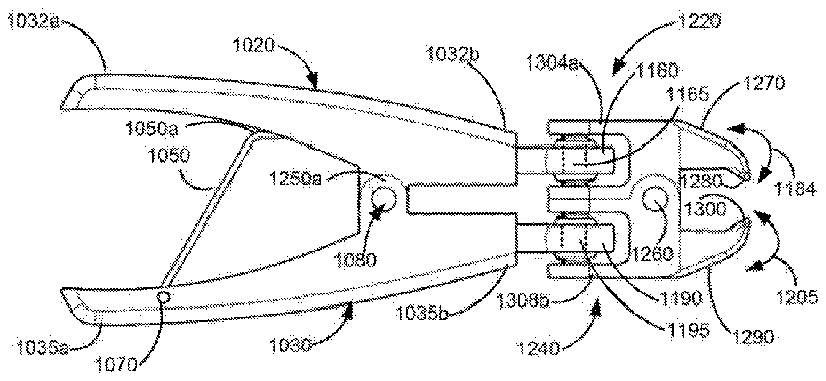
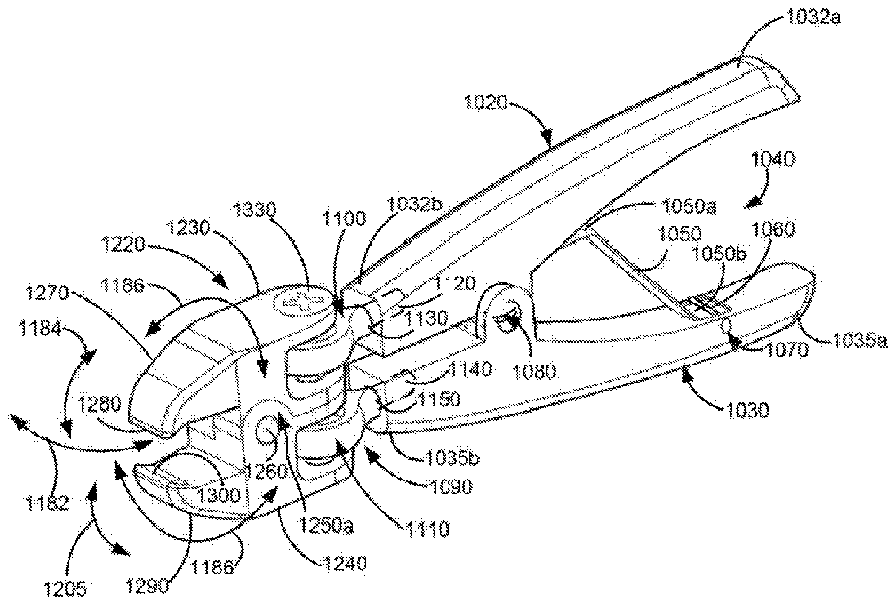
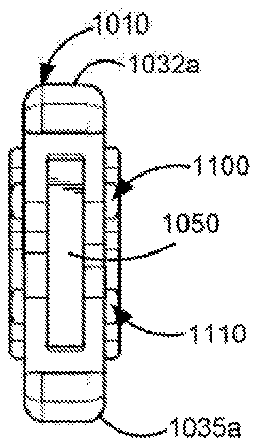
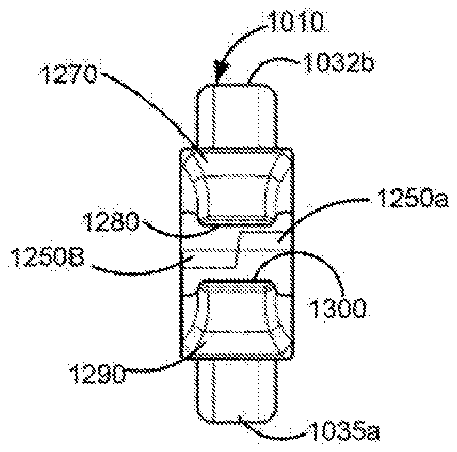
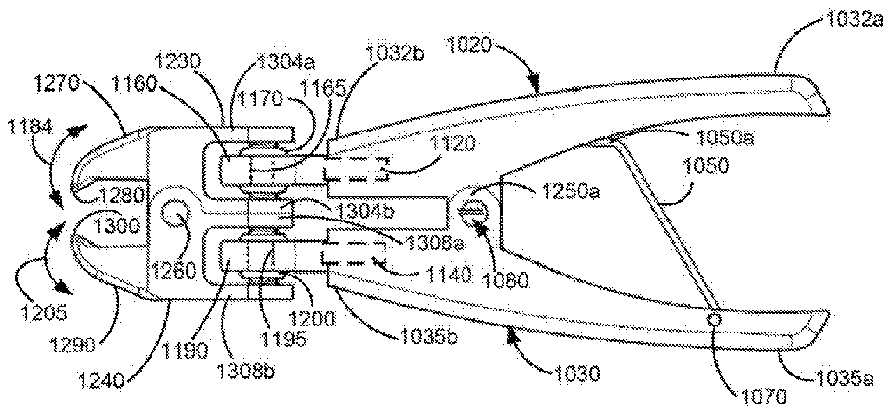
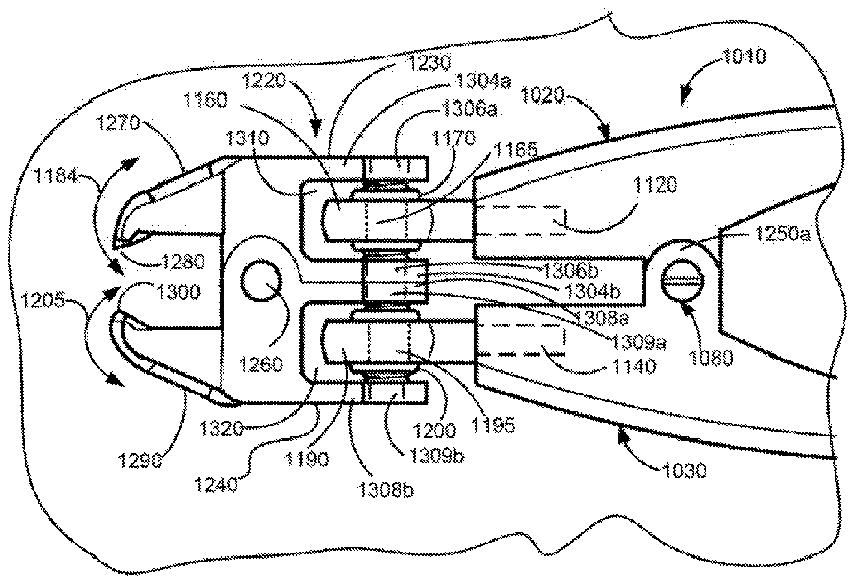
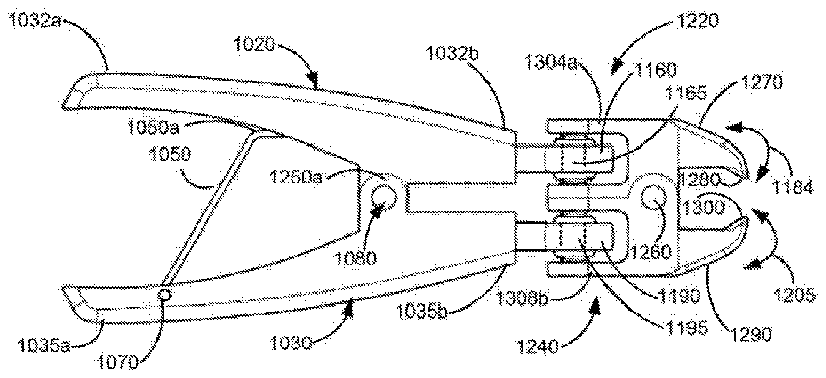
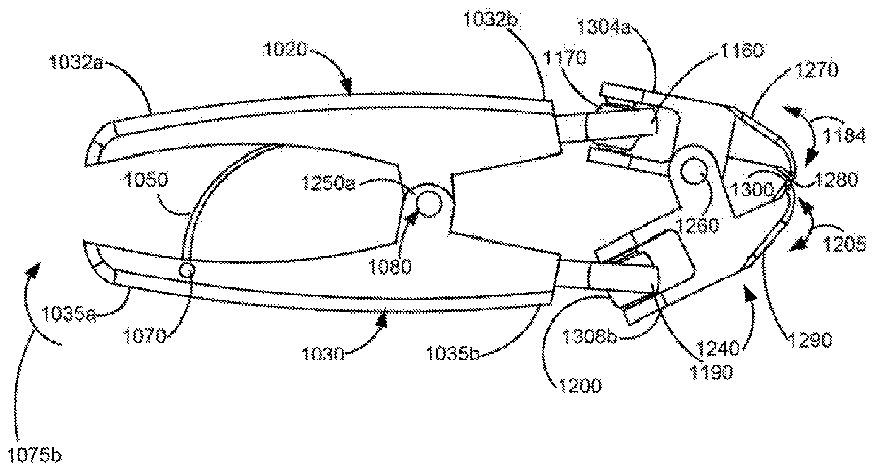
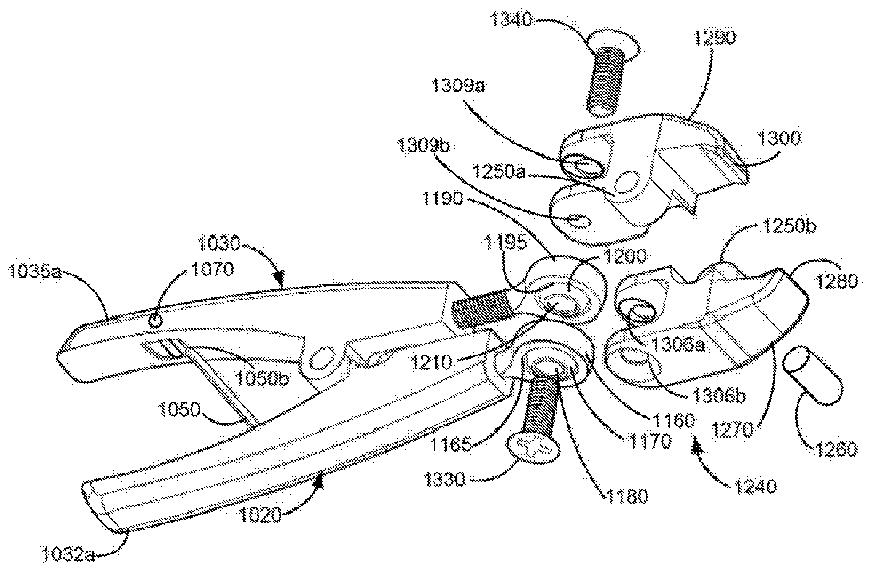
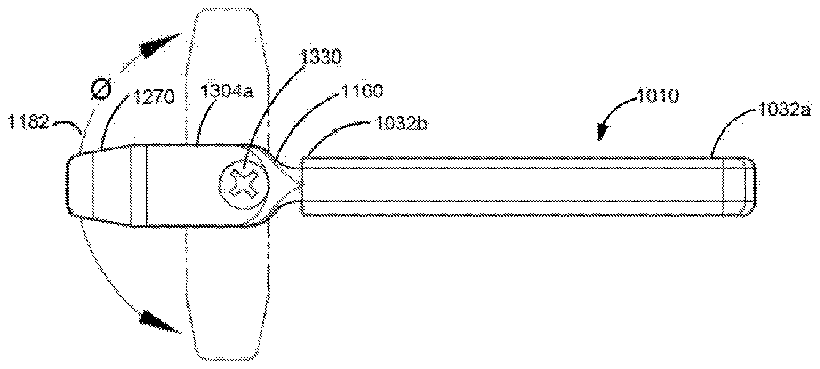
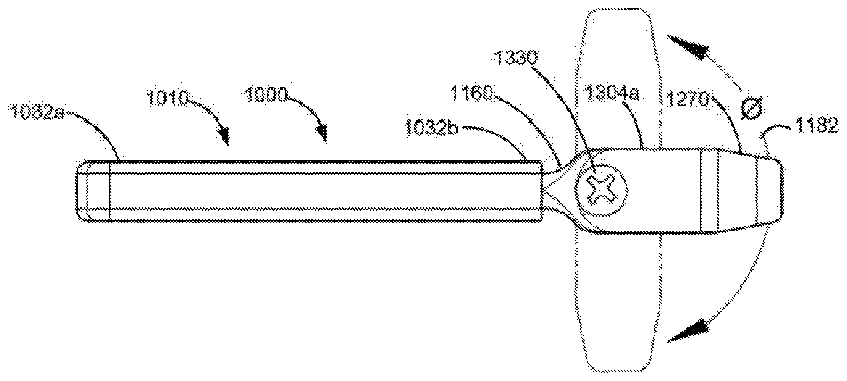
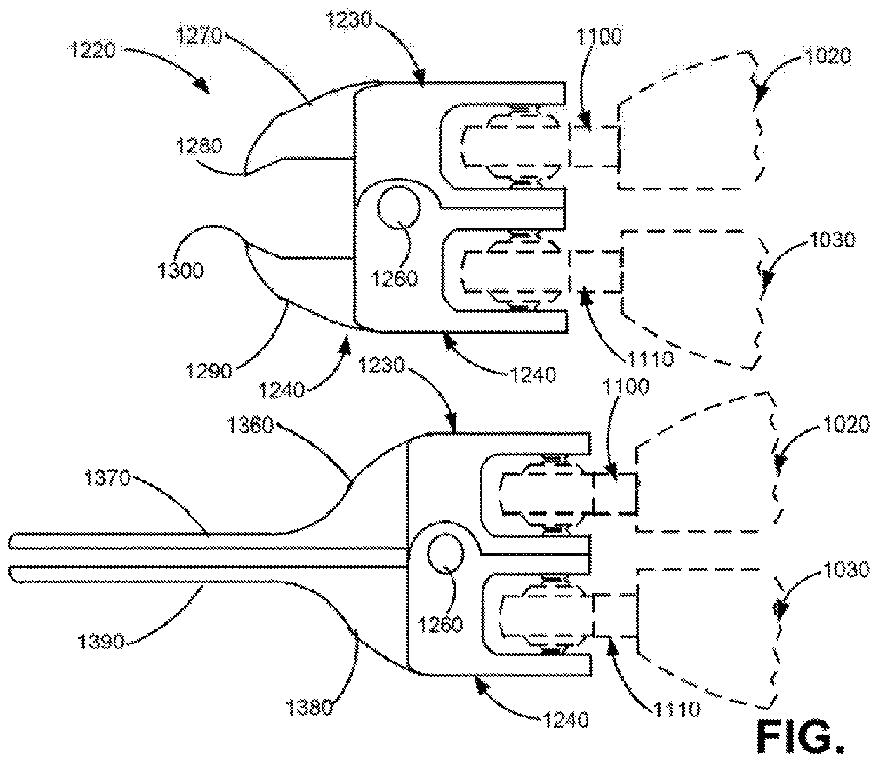
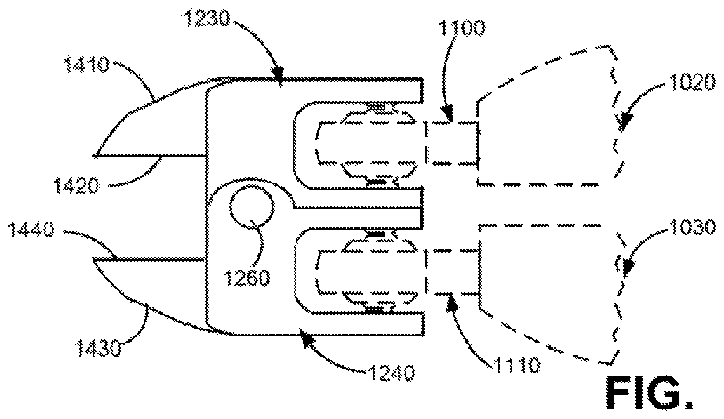
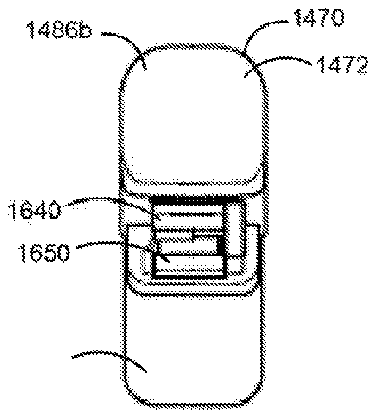
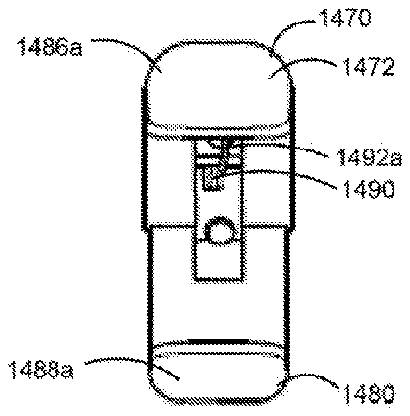
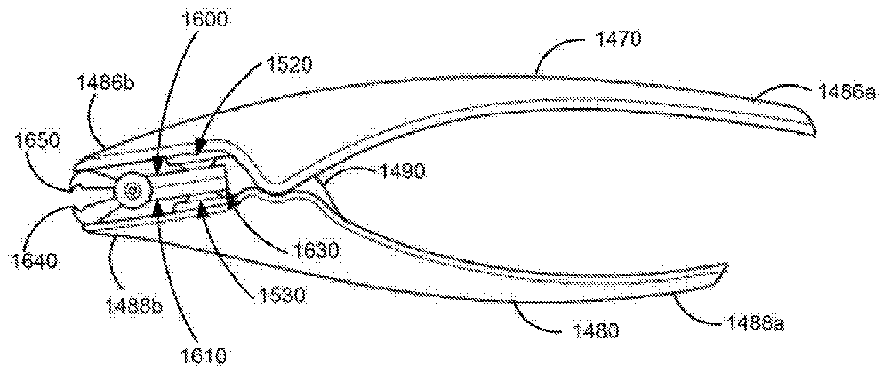
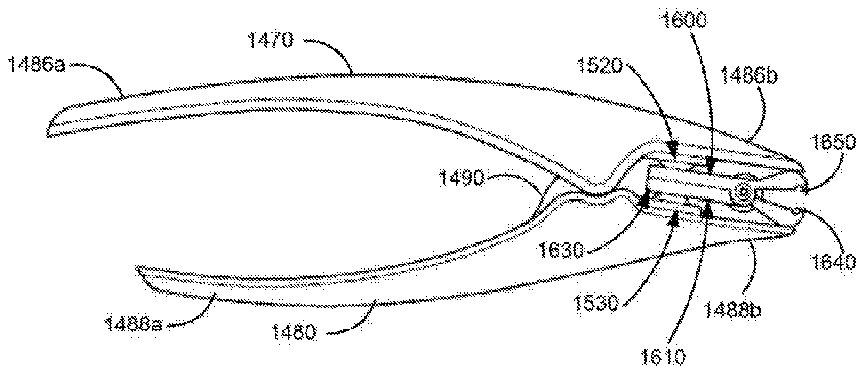
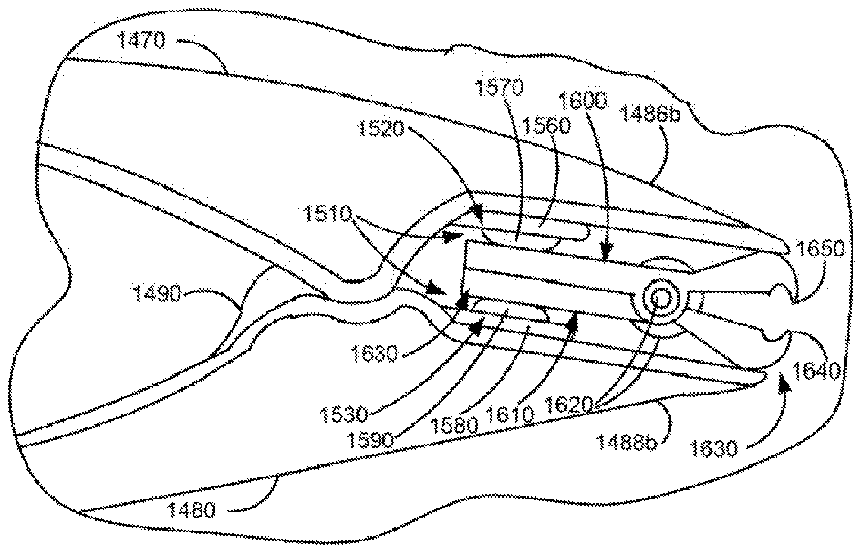
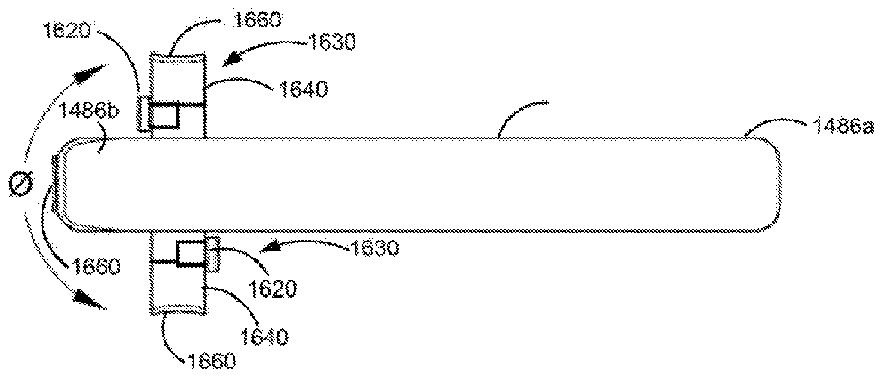
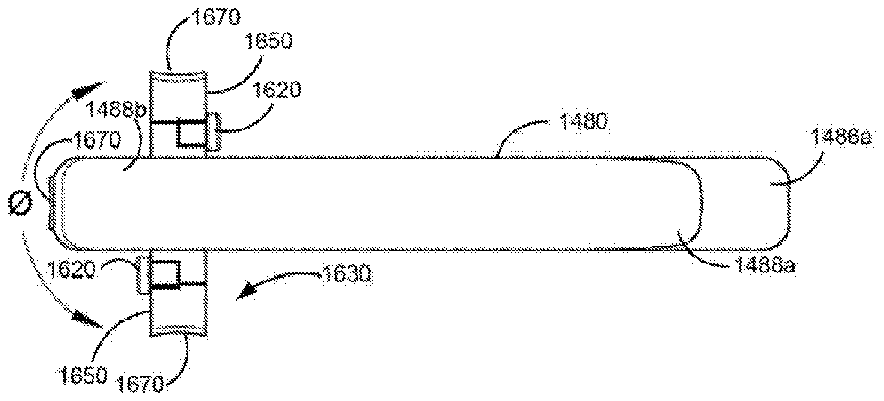
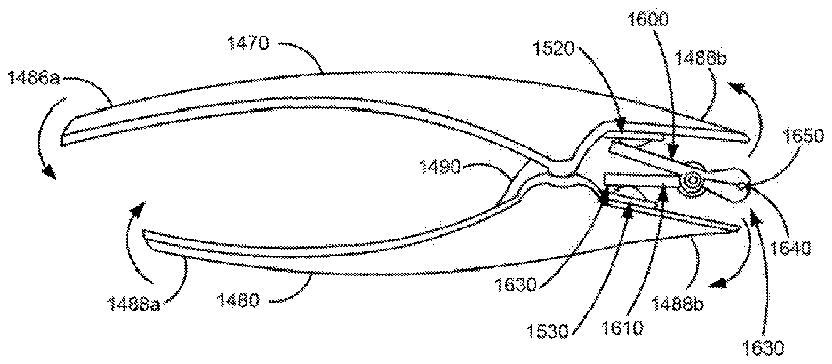
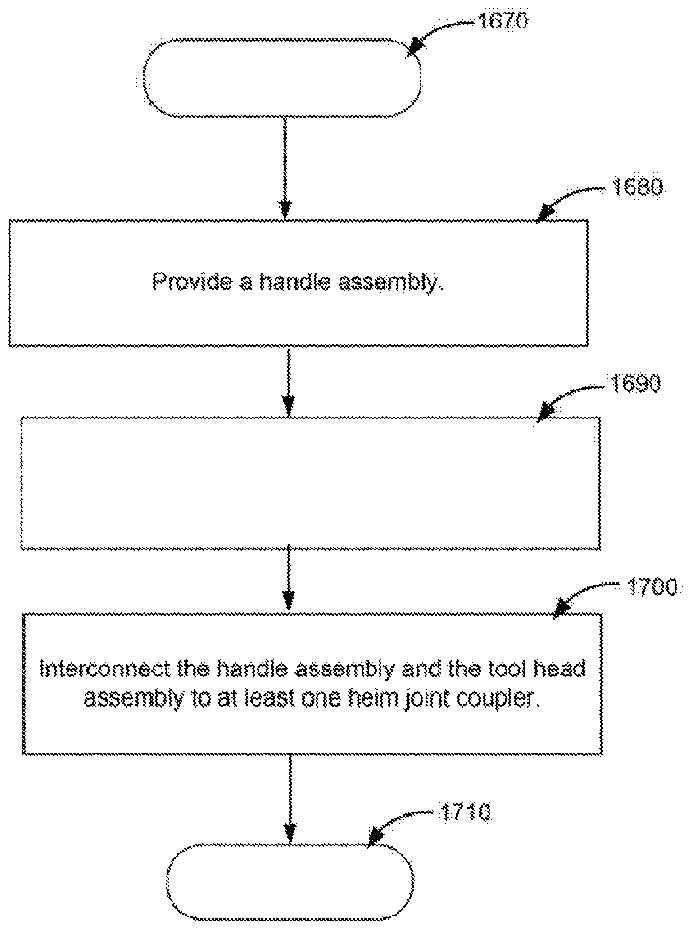
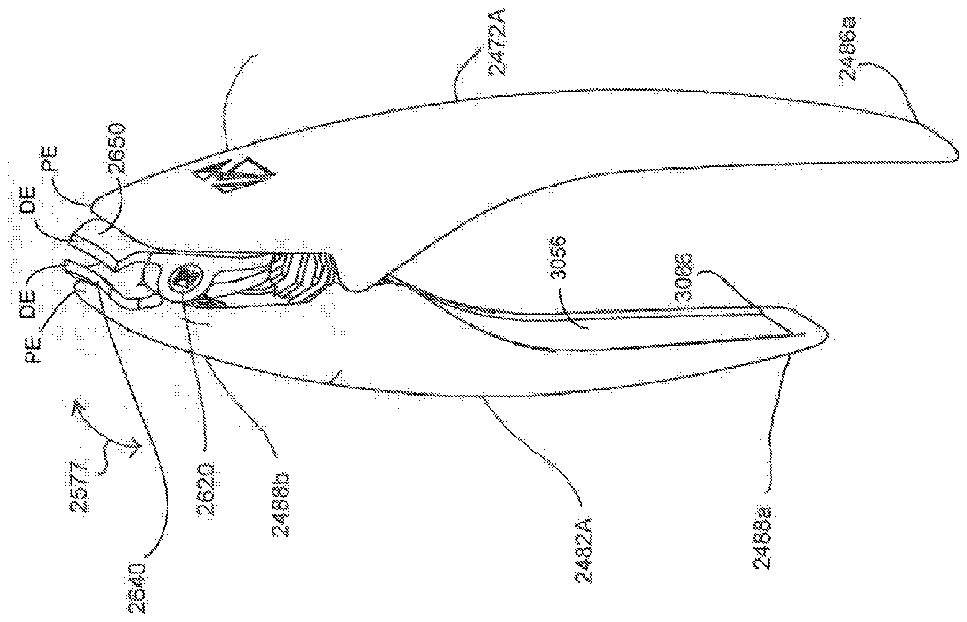
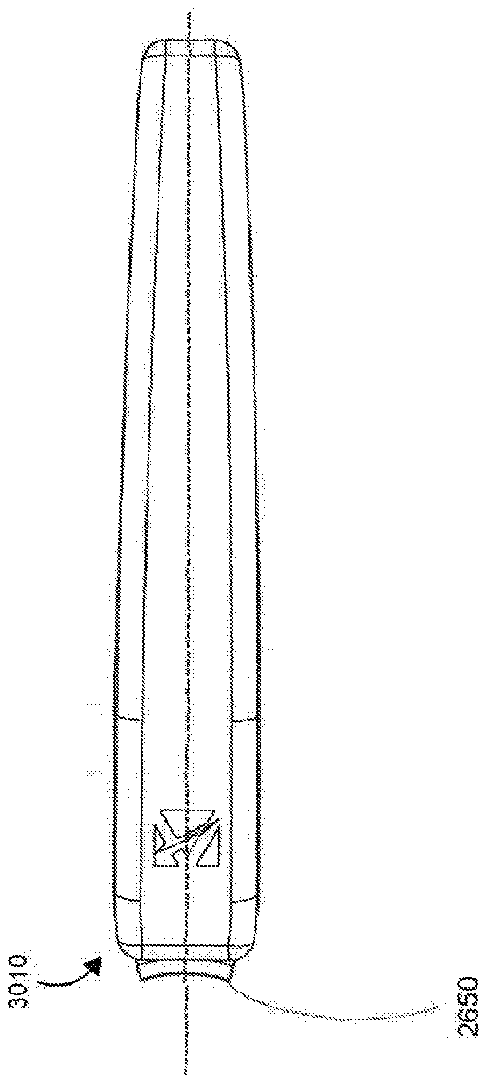
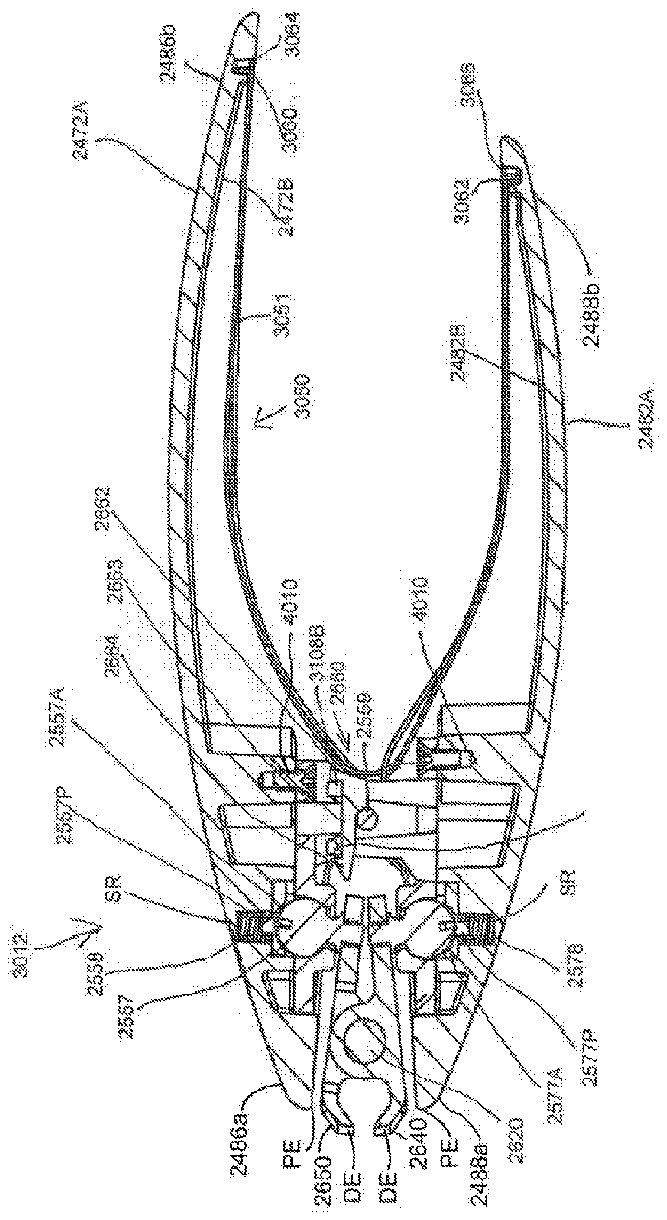
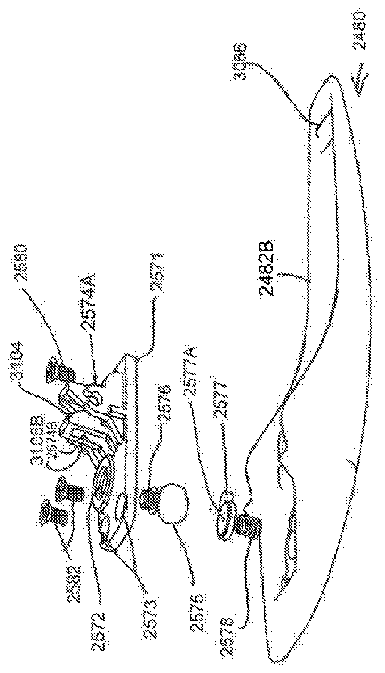

- 2parts turns see column
- 30about
- 301lower tool handle assembly
Abstract
A work tool includes a tool handle assembly that is moveable between an open default position and a closed working position. The tool handle assembly is constructed with an upper tool handle assembly and a lower tool handle assembly where the upper tool handle assembly and the lower tool handle assembly are configured to be snap-fit together to enable pivotal movement between the upper tool handle assembly and the lower tool handle assembly. The tool handle assembly further includes an attack angle orientation assembly carried partially by the upper tool handle assembly and carried partially by the lower tool handle assembly to facilitate pivotally closing a pair of cutting blades to operate on a work piece; the cutting blades are carried into alignment with a cutting blade plane defined by an imaginary cutting plane line extending between proximal end portions of the upper tool handle assembly and the lower tool handle assembly to prevent the pair of cutting blades from over-cutting a work piece beyond the cutting blade plane. The tool handle assembly further includes a biasing member which is secured between the upper tool handle assembly and the lower tool handle assembly in order to bias the tool handle assembly to an open default position and in order to bias the pair of cutting blades into an object receiving open position.
Description
CROSS-REFERENCE TO RELATED APPLICATIONS
[0001] This application is a continuation-in-part of U.S. patent application Ser. No. 14/037,146, filed on Sep. 25, 2013, which is a continuation-in-part of U.S. design patent application Ser. No. 29/467,935, filed concurrently on Sep. 25, 2013, which is now U.S. Pat. No. D724,916, issued on Mar. 24, 2015, which application is a continuation-in-part of International Application No. PCT/US2009/001442, filed Mar. 4, 2009 designating the United States and other countries, which is a continuation of U.S. application Ser. No. 12/137,482, filed Jun. 11, 2008, now U.S. Pat. No. 7,717,017 issued on May 18, 2010, the disclosures of which are hereby incorporated by reference in their entirety to provide continuity of disclosure to the extent such disclosures are not inconsistent with the disclosure herein.
FIELD OF THE INVENTION
[0002] This invention generally relates to tools and more particularly relates to hand tools and methods of manufacturing and using same.
BACKGROUND OF THE INVENTION
[0003] Conventional hand tools, such as conventional fingernail and toe nail clippers, have proven problematic to use, particularly when used by the elderly, arthritic individuals, stroke victims and others who have limited range of arm, wrist and hand movement.
[0004] More specifically, conventional fingernail and toe nail clippers have a spring handle that pivots about a fulcrum. Connected to the handle is a lever that is configured to downwardly press against the handle, so as to cause cutting edges formed on the handle to contact each other. However, the handle and lever must be in alignment with each other during the nail clipping operation to achieve efficient operation of the device.
[0005] Movement of the handle and lever into alignment during the nail clipping operation requires extensive manipulation of the handle and lever and extensive dexterity on the part of the user. Such extensive manipulation and need for extensive dexterity is problematic for elderly persons, arthritic individuals, stroke victims and others having limited arm, wrist and hand movement.
[0006] As another example, with respect to surgical instruments, it is often necessary to perform surgery on difficult-to-reach areas of the human body without obstructing the surgeon's field of view. This is also true with respect to veterinarians who perform surgery on animals. Also, in the specific case of surgery, it is also often necessary for the surgeon to use one surgical instrument, such as scissors, to perform a clipping/cutting procedure on a body structure, while using another surgical instrument, such as forceps or clamps, to hold the body structure. These two surgical instruments typically have significantly different fixed configurations. Having to stock a multiplicity of surgical instruments in hospital inventory with significantly different fixed configurations for performing different surgical functions is inconvenient and costly.
[0007] As a further example, with respect to wire and bolt cutters, it is sometimes necessary to sever cables and bolts located in confined spaces and recesses. This may be necessary when performing machinery repair, remodeling/renovating buildings, rescue of persons trapped by fallen building structure and debris, and rescue of persons trapped in damaged automobiles due to a collision. Use of cable and bolt cutters having configurations with cutting edges in a permanent, fixed orientation can make such cutting operations more difficult.
[0008] Attempts have been made to address the considerations mentioned hereinabove with respect to the structure and use of hand tools. For example, U.S. Pat. No. 5,062,666 titled “Nail Clipper” issued Nov. 12, 1991, in the name of Jaw-Shiunn Tsay relates to an improved nail dipper.
[0009] According to the Tsay patent, the nail dipper comprises an elongate lever, a short upper body, a long lower body and a joint pin to assemble the lever and both the upper and the lower bodies together at their front sections, so that the lever can be pressed down to compress the upper body downward on the lower body. The nail dipper further comprises two opposed pairs of curved cutting edges provided on opposite sides of the upper and the lower bodies (see FIGS. 3, 4, 5 and 6 of the Tsay patent). The cutting edges are fixed at two positions, one position being perpendicular to the other position. This patent states that an advantage of the nail clipper is that the two pairs of cutting edges can easily clip nails on the other hand after finishing one hand.
[0010] However, the Tsay patent discloses that the cutting edges are fixed at two positions, one position being perpendicular to the other position. Fixing the cutting edges at two positions may nonetheless require a user to extensively manipulate the nail clipper to clip nails. Requiring the user to extensively manipulate the nail dipper to clip nails is inconvenient for the user.
[0011] Another attempt to address the considerations mentioned hereinabove with respect to the structure and use of hand tools is disclosed in U.S. Pat. No. 3,742,957 titled “Surgical Clamp” issued Jul. 3, 1973, in the name of Jack H. White. The White patent relates to surgical and like clamps.
[0012] According to the White patent, a clamp includes a set of jaws including a gripping portion and an actuating portion and pin means pivotally connecting the jaws for movement between open and closed positions within a first plane. A set of handles comprising crank arms are disposed and operable between the open and closed positions within a second plane. The second plane is mutually intersecting with the first plane and the crank arms are connected to the actuating portion of the jaws at the junctures of respective leg portions of the crank arms. As mentioned in the White patent, this connection comprises a hinge for infinite angular positioning of the first plane containing the jaws with respect to the second plane containing the crank arms. Also, the leg portions of the crank arms are pivotally joined by a pin, which in the illustrated embodiment comprises a screw, to provide for opening and closing movement of the handles.
[0013] However, the White patent discloses that opening and closing movement of the handles is accomplished by adjustment of a screw (i.e., pin) that joins the handles. Only allowing opening and closing movement of the handles by means of a screw creates unnecessary delay in adjusting the clamp before surgery, readjusting the clamp during surgery, if necessary, and releasing the clamp after surgery because a screw driver is apparently needed to adjust the screw. Such a delay before, during and after a surgical procedure is undesirable.
[0014] Another attempt to address the considerations mentioned hereinabove with respect to the structure and use of hand tools is disclosed in U.S. Pat. No. 2,020,242 titled “Swivel Head Tool” issued Nov. 5, 1935, in the name of G. W. Geddes. The Geddes patent relates to tools in which the jaws may be placed in various angular positions relative to an operating handle system.
[0015] According to the Geddes patent, a bolt clipper embodying a jaw lever system and an actuating handle lever system are provided. The jaw levers can be adjusted to various angular positions relative to the plane of the handle levers so as to permit operating swinging movement of the jaws. For this purpose, joints embodying mating spherical surfaces and tail portions of the jaw levers are provided with shallow recesses of spherical contour, which receive interposed balls on which at least of one of the parts turns (see column 2, lines 15-37 of the Geddes patent). This patent also discloses that handle members are apparently pivotally mounted by means of a screw-like pin.
[0016] Although the Geddes patent discloses handle members that are pivotally mounted, this patent apparently requires adjustment of a screw-like pin in order to return the handle members to their default position. Requiring adjustment of the screw-like pin in order to return the handle members to their default position is inconvenient for the user because a screw driver is apparently needed to adjust the screw-like pin.
[0017] Although the approaches recited hereinabove disclose various configurations of hand tools, the approaches recited hereinabove do not appear to disclose the invention described and claimed herein below.
SUMMARY OF THE INVENTION
[0018] The present invention addresses the shortcomings of the prior art approaches mentioned hereinabove by providing a suitable hand tool, and method of manufacturing and using same.
[0019] According to a first embodiment of the present invention, the hand tool comprises a handle assembly that, in use, is oriented in a y-axis plane. The handle assembly is sized and contoured to be manipulated by hand. In this regard, the handle assembly includes a generally smooth, arcuate-shaped upper handle member and a generally smooth, arcuate-shaped lower handle member disposed opposite the upper handle member. In this manner, the upper handle member and the lower handle member are disposed in the same y-axis plane for grasping by the user. In addition, the upper handle member and the lower handle member are pivotally linked or pivotally joined together by a linkage bolt that allows pivoting action of the handle members in the y-axis plane. That is, the upper and lower handle members pivot toward each other to a closed position when the user grasps and simultaneously applies manual pressure to the upper and lower handle members. A biasing member, which may be in the form of a leaf spring, is interposed between the handle members for automatically biasing the handle members away from each other in order to return the handle members to their default open position after hand pressure is released.
[0020] The hand tool also comprises a coupler assembly including an upper coupler and a lower coupler. The upper coupler includes an articulating upper heim joint and the lower coupler includes an articulating lower helm joint. The upper heim joint is connected to the upper handle member and the lower heim joint is connected to the lower handle member. The upper and lower heim joints are each provided with threaded shanks for threadably engaging their respective upper and lower handle members. In this manner, the upper and lower helm joints are fixedly attached to their respective upper and lower handle members. As known in the art, a helm joint (i.e., also referred to in the art as a rose joint, rod end bearing, or heim bearing) allows multi-directional, such as side-to-side (i.e., rotational or swiveling), and tilting, substantially frictionless movement of a component connected to it without breaking of the component.
[0021] As contemplated by the invention, a component comprising a tool head is connected to the upper and lower helm joints. The tool head can be fingernail or toe nail clipper blades, surgical clamp jaws, bolt cutter blades or other tool head. For example, with respect to blade tools (e.g., fingernail or toe nail dippers, bolt cutters), the tool head comprises an upper blade tool pivotally connected to the upper heim joint and a lower blade tool pivotally connected to the lower helm joint. A pivot pin joins the upper blade tool and the lower blade tool. In this manner, the pivot pin, upper heim joint and lower heim joint cooperate to allow simultaneous side-to-side (i.e., rotational or swiveling) movement of the upper and lower blade tools in addition to allowing closing and opening of the blade tools. The user manually moves the blade tools to a desired side-to-side (i.e., rotated, swiveled) and/or tilted orientation for operating on a work piece. When the user grasps and simultaneously applies manual pressure to the upper and lower handle members, the upper and lower handle members pivot toward each other and lock in position. As the upper and lower handle members pivot toward each other, the upper and lower blade tools also pivot toward each other due to the previously mentioned interconnection of the blade tools with the handle members. As the upper and lower blade tools pivot toward each other in this manner, the upper blade tool and the lower blade tool close. Conversely, as manual pressure is released, the upper and lower handle members automatically pivot away from each other due to presence of the biasing member interposed between them. Thus, as the upper and lower handle members pivot away from each other, the upper blade tool and the lower blade tool open, which is the default position of the device. In this manner, manual actuation of the handle members, in cooperation with the heim joints that interconnect the tool head assembly and the handle assembly, allow opening and closing of the upper and lower blade tools.
[0022] The upper and lower heim joints allow their respective upper and lower blade tools to swivel or rotate side-to-side at least 180° degrees in the x-plane and tilt a limited amount (e.g., about 30° degrees) in the x and y axes planes in order to conveniently position the upper and lower blade tools at a desired location on the work piece. As previously mentioned, means are provided for locking the angular (i.e., rotational, swivel or side-to-side) and tilted position of the upper and lower blade tools. In other words, once the upper and lower blade tools are positioned at the desired location on the work piece, the handle members are closed in order to lock the upper and lower blade tools in their angular position and to actuate the upper and lower blade tools, so that the upper and lower blade tools close, as previously mentioned, to cut the work piece.
[0023] Thus, the upper blade tool, lower blade tool, pivot pin, upper helm joint, and lower heim joint cooperate to allow the upper blade tool and lower blade tool to simultaneously swivel or rotate at least 180° degrees in the x-axis plane and tilt a limited amount (i.e., about 30° degrees) in the x and y axes planes for positioning the upper blade tool and lower tool at the desired location for operating on the work piece.
[0024] In this first embodiment of the invention, the tool head is detachable from the heim joints by means described in detail herein below. This allows decoupling of the tool head from the helm joints, so that different types of tool heads and various sizes of the same type of tool head can be interchanged. Also, providing for detachment or decoupling of the tool head from the heim joints allows replacement of a worn tool head. Thus, the hand tool of the present invention is versatile and accommodates tool heads required for different applications.
[0025] Therefore, the 180° degree rotational (i.e., swivel) feature and the tilting feature allow the hand tool of the first embodiment of the invention to obtain a variable angle of attack on a work piece. Obtaining such a variable of attack allows the hand tool to be conveniently manipulated in a manner that is particularly useful for elderly persons, arthritic individuals, stroke victims and others who have a limited range of arm, wrist and hand movement. The variable angle of attack also allows the hand tool to be conveniently manipulated in a manner that is particularly useful for performing surgical procedures on structures located in difficult-to-reach areas of the human body without obstructing the surgeon's field of view. In addition, the variable angle of attack allows the hand tool to be conveniently manipulated in a manner for cutting cables and bolts located in difficult to access, confined spaces.
[0026] A second embodiment of the invention is strictly in the form of a fingernail or toe nail dipper and has some features similar to the features of the first embodiment of the invention. In this regard, the second embodiment of the invention comprises a pair of handle members each including a relatively thin, arcuate-shaped outer shell matingly mounted on an arcuate-shaped inner supporting frame member. The outer shell covers the frame member, so that the frame member is not substantially visible. The outer shell may be formed from an aesthetically pleasing, decorative polymer plastic material, or other aesthetically pleasing material, and the frame member may be a light weight metal, metal alloy or other light-weight composition, so that the nail clipper may be easily carried in pocket or purse. A pair of oppositely disposed, pivotable cutting edges are interposed between distal end portions of the handle members and are generally concealed from view by the distal end portions of the handle members when viewed from the top or bottom of the device. A pair of heim joints interconnects respective ones of the pair of handle members with respective ones of the pair of cutting edges. The heim joints allow side-to-side rotational or swiveling movement of the cutting edges through an angle of about 180° degrees. The upper handle member and the lower handle member are pivotally joined together by a pivot pin that allows pivoting action of the handle members in the y-axis plane. The upper and lower handle members pivot toward each other to a closed position when the user grasps and simultaneously applies manual pressure to the upper and lower handle members. The cutting edges are simultaneously locked in position and cut the fingernails or toe nails of the user when hand pressure is applied to close the handle members. A biasing member, which may be in the form of a torsion spring, is interposed between the handle members for biasing the handle members to their open default position when hand pressure is released by the user.
[0027] Therefore, the 180° degree side-to-side (i.e., rotational or swivel) movement feature of the cutting edges belonging to this second embodiment of the invention allows the device to obtain a variable angle of attack, so that fingernails and toe nails can be conveniently dipped by elderly persons, arthritic individuals, stroke victims and others who have a limited range of arm, wrist and hand movement.
[0028] According to an aspect of the present invention, there is provided a hand tool comprising a handle assembly oriented in a first plane and sized for hand manipulation; a tool head assembly coupled to the handle assembly for operating on a work piece in response to hand manipulation of the handle assembly; and at least one heim joint coupler interconnecting the handle assembly and the tool head assembly for rotating the tool head assembly to a selected angle relative to the handle assembly.
[0029] According to another aspect of the present invention, there is provided a hand tool, comprising: a handle assembly including a pair of handles oriented in a first plane and sized for hand manipulation; a tool head assembly coupled to the handle assembly for operating on a work piece in response to hand manipulation of the pair of handles; and at least one heim joint coupler interconnecting the handle assembly and the tool head assembly for rotating the tool head assembly to a selected angle relative to the handle assembly, so that the tool head assembly is oriented to operate on the work piece at the selected angle.
[0030] According to yet another aspect of the present invention, there is provided a method of manufacturing a hand tool, comprising the steps of: providing a handle assembly; coupling a tool head assembly to the handle assembly; and interconnecting the handle assembly and the tool head assembly to at least one heim joint coupler.
[0031] A feature of the present invention is the provision of a tool head assembly coupled to a handle assembly for operating on a work piece in response to hand manipulation of the handle assembly, the tool head assembly being adapted to operate on the work piece at a selected angle.
[0032] Another feature of the present invention is the provision of at least one heim joint coupler interconnecting the handle assembly and the tool head assembly.
[0033] In addition to the foregoing, various other method and/or device aspects and features are set forth and described in the teachings, such as text (e.g., claims and/or detailed description) and/or drawings of the present invention.
[0034] A third embodiment of the invention is also strictly in the form of a work tool and has some features similar to the features of the first and second embodiments of the invention. In this regard, the third embodiment of the invention is a work tool, comprising: a handle assembly moveable between an open default position and a closed working position and having an upper handle assembly and a lower handle assembly; wherein said upper handle assembly and said lower handle assembly are configured to be snap-fit together to enable pivotal movement between said upper handle assembly and said lower handle assembly; an attack angle orientation assembly carried partially by said upper handle assembly and carried partially by said lower handle assembly to facilitate pivotally closing a pair of cutting blades at a desired attack angle, wherein said cutting blades are carried into alignment with a cutting blade plane, said cutting plane extending between proximal end portions of said upper handle assembly and said lower handle assembly to prevent said pair of cutting blades from operating on a work piece beyond the cutting blade plane; and a biasing member secured between said upper handle assembly and said lower handle assembly for biasing said handle assembly to the open default position.
[0035] In another aspect of this third embodiment of the present invention, the work tool further comprises a locking assembly to secure said upper handle assembly and said lower handle assembly pivotally together to facilitate pivotal movement between said upper handle assembly and said lower handle assembly, and wherein said locking assembly includes a locking pin to permanently secure together said upper handle assembly and said lower handle assembly and to facilitate pivotal movement between said upper handle assembly and said lower handle assembly.
[0036] In still another aspect of this third embodiment of the present invention, the work tool further comprises an upper bracket operatively attached to the upper handle assembly; and a lower bracket operatively attached to the lower handle assembly.
[0037] In yet another aspect of this third embodiment of the present invention, the work tool further comprises a pivot cylinder located on the upper bracket; and a pivot cylinder connector located on the lower bracket, wherein the pivot cylinder and the pivot cylinder connector are snap-fit together to enable pivotal movement between said upper handle assembly and said lower handle assembly.
[0038] In a further aspect of this third embodiment of the present invention, the attack angle orientation assembly comprises a blade assembly having one of the pair of cutting blades located at one end of the blade assembly; and another blade assembly having the other of the pair of cutting blades located at one end of the another blade assembly.
[0039] In a yet further aspect of this third embodiment of the present invention, the attack angle orientation assembly comprises a multi-directional coupler operatively connected at another end of the blade assembly; and another multi-directional coupler operatively connected at another end of the another blade assembly.
[0040] In a still further aspect of this third embodiment of the present invention, the multi-directional coupler comprises a ball swivel having a shank portion located at one end, wherein the shank portion is operatively connected to the another end of the blade assembly; a spherical opening in the handle assembly for receiving the ball swivel; a buffer located adjacent to the ball swivel; and a spring located between the buffer and the handle assembly for retaining the ball swivel within the spherical opening.
[0041] In an even further aspect of this third embodiment of the present invention, the another multi-directional coupler comprises another ball swivel having a shank portion located at one end, wherein the shank portion is operatively connected to the another end of the another blade assembly; another spherical opening in the handle assembly for receiving the another ball swivel; another buffer located adjacent to the another ball swivel; and another spring located between the another buffer and the handle assembly for retaining the another ball swivel within the another spherical opening.
[0042] In a still even further aspect of this third embodiment of the present invention, the attack angle orientation assembly comprises a pivot carried by the blade assembly and the another blade assembly to facilitate pivotally closing the pair of cutting blades at a desired attack angle.
[0043] In another embodiment of the third embodiment of the present invention, the another embodiment comprises a hand tool, which includes a handle assembly sized for hand manipulation and having an upper handle assembly and a lower handle assembly, wherein said upper handle assembly and said lower handle assembly are configured to be secured together to enable pivotal movement; a locking assembly to secure said upper handle assembly and said lower handle assembly pivotally together and to facilitate pivotal movement between said upper handle assembly and said lower handle assembly; an attack angle orientation assembly carried by said upper handle assembly and said lower handle assembly to facilitate pivotally closing a pair of cutting blades at a desired attack angle, wherein said cutting blades are carried into alignment with a cutting blade plane, said cutting plane extending between proximal end portions of said upper handle assembly and said lower handle assembly to prevent said pair of cutting blades from operating on a work piece beyond the cutting blade plane; and a biasing member secured between said upper handle assembly and said lower handle assembly for biasing said handle assembly to an open position.
[0044] In another aspect of this third embodiment of the present invention, the locking assembly includes a locking pin to permanently secure together said upper handle assembly and said lower handle assembly and to facilitate pivotal movement between said upper handle assembly and said lower handle assembly.
[0045] In yet another aspect of this third embodiment of the present invention, the attack angle orientation assembly comprises a blade assembly having one of the pair of cutting blades located at one end of the blade assembly; and another blade assembly having the other of the pair of cutting blades located at one end of the another blade assembly.
[0046] In still another aspect of this third embodiment of the present invention, the attack angle orientation assembly comprises a multi-directional coupler operatively connected at another end of the blade assembly; and another multi-directional coupler operatively connected at another end of the another blade assembly.
[0047] In a further aspect of this third embodiment of the present invention, the multi-directional coupler comprises a ball swivel having a shank portion located at one end, wherein the shank portion is operatively connected to the another end of the blade assembly; a spherical opening in the handle assembly for receiving the ball swivel; a buffer located adjacent to the ball swivel; and a spring located between the buffer and the handle assembly for retaining the ball swivel within the spherical opening.
[0048] In an even further aspect of this third embodiment of the present invention, the another multi-directional coupler comprises another ball swivel having a shank portion located at one end, wherein the shank portion is operatively connected to the another end of the another blade assembly; another spherical opening in the handle assembly for receiving the another ball swivel; another buffer located adjacent to the another ball swivel; and another spring located between the another buffer and the handle assembly for retaining the another ball swivel within the another spherical opening.
[0049] In a yet further aspect of this third embodiment of the present invention, the attack angle orientation assembly comprises a pivot carried by the blade assembly and the another blade assembly to facilitate pivotally closing the pair of cutting blades at a desired attack angle.
[0050] In still another embodiment of the third embodiment of the present invention, the still another embodiment comprises a work tool including a handle assembly sized for hand manipulation and having an upper handle assembly and a lower handle assembly; wherein said upper handle assembly and said lower handle assembly are configured to be secured together to enable pivotal movement; a locking assembly to secure said upper handle assembly and said lower handle assembly pivotally together to facilitate pivotal movement between said upper handle assembly and said lower handle assembly, an attack angle orientation assembly carried by said upper handle assembly and by said lower handle assembly to facilitate pivotally closing a pair of cutting blades at a desired attack angle, wherein the attack angle orientation assembly includes a multi-directional coupler attached at one end to the upper handle assembly and another multi-directional coupler attached at one end to the lower handle assembly; wherein said cutting blades are carried into alignment with a cutting blade plane, said cutting plane extending between proximal end portions of said upper handle assembly and said lower handle assembly to prevent said pair of cutting blades from operating on a work piece beyond the cutting blade plane; and a biasing member secured between said upper handle assembly and said lower handle assembly for biasing said handle assembly to the open default position.
[0051] In another aspect of this third embodiment of the present invention, the locking assembly includes a locking pin to permanently secure together said upper handle assembly and said lower handle assembly and to facilitate pivotal movement between said upper handle assembly and said lower handle assembly.
[0052] In yet another aspect of this third embodiment of the present invention, the attack angle orientation assembly comprises a blade assembly having one of the pair of cutting blades located at one end of the blade assembly and attached to the multi-directional coupler at another end of the blade assembly; and another blade assembly having the other of the pair of cutting blades located at one end of the another blade assembly and attached to the another multi-directional coupler at another end of the another blade assembly.
[0053] In still another aspect of this third embodiment of the present invention, the attack angle orientation assembly comprises a pivot carried by the blade assembly and the another blade assembly to facilitate pivotally closing the pair of cutting blades at a desired attack angle.
[0054] The foregoing is a summary and thus may contain simplifications, generalizations, inclusions, and/or omissions of detail. Consequently, those skilled in the art will appreciate that the summary is illustrative only and is not intended to be in any way limiting. In addition to the illustrative aspects, embodiments, and features described hereinabove, further aspects, embodiments, and features will become apparent by reference to the drawings and the following detailed description.
BRIEF DESCRIPTION OF THE DRAWINGS
[0055] The invention will be more fully understood by reference to the detailed description in conjunction with the following figures, wherein:
[0056] FIG. 1 is a view in perspective of a first embodiment hand tool including a first embodiment tool head assembly configured as a fingernail or toe nail clipper;
[0057] FIG. 2 is a rear view in elevation of the first embodiment hand tool;
[0058] FIG. 3 is a front view in elevation of the first embodiment hand tool;
[0059] FIG. 4 is a right side view in elevation of the first embodiment hand tool;
[0060] FIG. 4A is a fragmentary view in elevation of the right side of the first embodiment hand tool;
[0061] FIG. 5 is a left side view in elevation of the first embodiment hand tool, the first embodiment hand tool being shown in an open position;
[0062] FIG. 5A is a left side view in elevation of the first embodiment hand tool, the first embodiment hand tool being shown in a closed position;
[0063] FIG. 6 is a partially exploded view of the first embodiment hand tool;
[0064] FIG. 7 is a top plan view of the first embodiment hand tool;
[0065] FIG. 8 is a bottom plan view of the first embodiment hand tool;
[0066] FIG. 9 is a right side view in elevation of a detached first embodiment tool head assembly configured as a fingernail or toe nail clipper;
[0067] FIG. 10 is a right side view in elevation of a detached second embodiment tool head assembly configured as a surgical clamp;
[0068] FIG. 11 is a right side view in elevation of a detached third embodiment tool head assembly configured as a cable/bolt cutter;
[0069] FIG. 12 is a view in perspective of a second embodiment hand tool including a tool head assembly configured as a fingernail or toe nail clipper, the second embodiment hand tool being shown in an open position;
[0070] FIG. 13 is a front view in elevation of the second embodiment hand tool;
[0071] FIG. 14 is a rear view in elevation of the second embodiment hand tool;
[0072] FIG. 15 is a right side view in elevation of the second embodiment hand tool;
[0073] FIG. 16 is a left side view in elevation of the second embodiment hand tool;
[0074] FIG. 16A is a fragmentary view in elevation of a distal end portion of the second embodiment hand tool;
[0075] FIG. 17 is a top plan view of the second embodiment hand tool;
[0076] FIG. 18 is a bottom plan view of the second embodiment hand tool;
[0077] FIG. 18A is a view in elevation of the second embodiment hand tool in a closed position;
[0078] FIG. 19 is an exploded view of the second embodiment hand tool;
[0079] FIG. 20 is a flowchart showing an illustrative method of manufacturing the first and second embodiments of the hand tool;
[0080] FIG. 21 is a view in perspective of a third embodiment work tool, which is constructed in accordance with the present invention;
[0081] FIG. 22 is a top plan view of the third embodiment work tool;
[0082] FIG. 23 is a cross-sectional view of the work tool of FIG. 22 taken along line A-A, illustrating the blade assembly in an open position;
[0083] FIG. 24 is an exploded view of the third embodiment work tool;
[0084] FIG. 25 is a top plan view of the work tool; and
[0085] FIG. 26 is a cross-sectional view of the work tool of FIG. 25 taken along line A-A, illustrating the blade assembly in a closed position.
DETAILED DESCRIPTION OF PREFERRED EMBODIMENTS
[0086] In the following detailed description, reference is made to the accompanying drawings, which form a part hereof. In the drawings, similar symbols typically identify similar components, unless context dictates otherwise. The illustrative embodiments described in the detailed description, drawings, and claims are not meant to be limiting. Other embodiments may be utilized, and other changes may be made, without departing from either the spirit or scope of the invention.
[0087] In addition, the present patent specification uses outline headings for clarity of presentation. However, it is to be understood that the outline headings are for presentation purposes, and that different types of subject matter may be discussed throughout the application (e.g., device(s)/structure(s) may be described under process(es)/operations heading(s) and/or process(es)/operations may be discussed under structure(s)/process(es) headings; and/or descriptions of single topics may span two or more topic headings). Hence, the use of the outline headings is not intended to be in any way limiting.
[0088] Therefore, with reference to FIGS. 1, 2 and 3 , there is shown a first embodiment hand tool, generally referred as 1000 , for operating on a work piece (not shown). In the exemplary embodiment illustrated, hand tool 1000 is a fingernail or toe nail clipper for clipping or cutting fingernails and toe nails of a user (also not shown). However, it will be appreciated that hand tool 1000 is not limited to the configuration of a fingernail or toe nail dipper. Rather, hand tool 1000 may be in the configuration of other types of hand tools, as well, such as clamps and bolt cutters.
[0089] Referring again to FIGS. 1, 2 and 3 , hand tool 1000 comprises a first embodiment hand held tool mount or handle assembly 1010 shown oriented in a y-axis or first plane. Handle assembly 1010 , which is sized for hand manipulation or grasping by the user, includes a generally smooth, contoured, arcuate-shaped upper handle member 1020 and a generally smooth, contoured, arcuate-shaped lower handle member 1030 disposed in the first plane opposite upper handle member 1020 . The contoured or arcuate shape of upper handle member 1020 and lower handle member 1030 facilitates grasping thereof by the user of hand tool 1000 . Upper handle member 1020 defines a proximal end portion 1032 a and a distal end portion 1032 b for reasons recited herein below. Similarly, lower handle member 1030 defines a proximal end portion 1035 a and a distal end portion 1035 b for reasons recited herein below. The handle assembly 1010 is also provided with a resilient biasing member in the form of an elongate leaf spring 1040 for reasons provided herein below. In this regard, leaf spring 1040 has a unitary construction that includes a central straight segment portion 1050 , which is disposed between an upper straight portion 1050 a and a lower rounded or curved end portion 1050 b . Upper straight portion 1050 a is positioned generally intermediate proximal end portion 1032 a and distal end portion 1032 b of upper handle member 1020 . Lower rounded or curved end portion 1050 b is positioned generally intermediate proximal end portion 1035 a and distal end portion 1035 b of lower handle member 1030 .
[0090] Still referring to FIGS. 1, 2 and 3 , in order to hold the handle members 1020 / 1030 apart, lower rounded or curved end portion 1050 b of leaf spring 1040 is mounted within a lower handle member cutout 1060 by a mounting or spring pin indicated generally at 1070 . Cutout 1060 is disposed at an inner rearward surface area of lower handle member 1030 in a manner that allows leaf spring 1040 to be disposed at an inclined angle between upper handle member 1020 and lower handle member 1030 . The opposite end of leaf spring 1040 , which terminates in upper straight portion 1050 a , permits the opposite or upper straight portion 1050 a to rest in engagement with an inner surface area of upper handle member 1020 . In short, leaf spring 1040 is wedged between upper handle member 1020 and lower handle member 1030 to provide a return force when the two handle members 1020 / 1030 are manually squeezed together by the user, such as in the direction of directional arrows 1075 a and 1075 b (see FIG. 5A ).
[0091] Referring again to FIGS. 1, 2, and 3 , upper handle member 1020 and lower handle member 1030 are pivotably connected to each other on an axis defined by a mounting or linkage bolt 1080 and are held apart from one another, in a default position, by the previously mentioned leaf spring 1040 . Linkage bolt 1080 therefore facilitates holding the two handle members 1020 / 1030 pivotally together. The previously mentioned return force is a force sufficient to cause the two handle members 102011030 to move pivotally away from one another about the axis defined by mounting or linkage bolt 1080 when handle members 1020 / 1030 are released by the user, so that handle members 1020 / 1030 return to their default or open positions as best seen in FIG. 1 . Although leaf spring 1040 of a particular configuration is illustrated, it should be understood by those skilled in the art that other suitable biasing or spring means may be utilized, such as a coiled compression spring (not shown) or other suitable spring means.
[0092] As shown in FIGS. 1, 2 and 3 , hand tool 1000 further includes a heim joint coupler assembly indicated generally at 1090 . The coupler assembly 1090 includes an upper mount or upper coupler in the form of an articulating upper heim joint 1100 . Coupler assembly 1090 further includes a lower mount or lower coupler in the form of an articulating lower heim joint 1110 . Upper heim joint 1100 is threadably attached to distal end portion 1032 b of upper handle member 1020 by means of an elongate, externally threaded upper shank portion 1120 that is received in an internally threaded upper bore or hole 1130 formed in distal end portion 1032 b . Similarly, lower helm joint 1110 is threadably attached to distal end portion 1035 b of lower handle member 1030 by means of an elongate, externally threaded lower shank portion 1140 that is received in an internally threaded lower bore or hole 1150 formed in distal end portion 1035 b . Thus, upper shank portion 1120 is threadably received in upper hole 1130 and lower shank portion 1140 is threadably received in lower hole 1150 for coupling shank portions 1120 / 1140 to handle members 1020 / 1030 , respectively. However, shank portions 1120 / 1140 and holes 1130 / 1150 need not be threaded; rather, shank portions 1120 / 1140 and holes 1130 / 1150 may be smooth and sized for allowing coupling of shank portions 1120 / 1140 to handle members 1020 / 1030 by means of a press-fit.
[0093] Referring to FIGS. 1, 4, 4A, 5, 5A and 6 , upper heim joint 1100 comprises an annular upper casing 1160 integrally attached to upper shank portion 1120 . Upper casing 1160 defines an opening 1165 there through for reasons provided herein below. In addition, upper casing 1160 may have a generally spherical interior (not shown) contoured for slidably, matingly receiving a spherical upper ball swivel 1170 , such that upper ball swivel 1170 is slidably retained within upper casing 1160 . Upper ball swivel 1170 defines an upper ball hole 1180 (see FIG. 6 ) centrally there through for reasons provided herein below. In this manner, upper ball swivel 1170 is capable of multi-directional, slidable movement within upper casing 1160 . In other words, upper ball swivel 1170 is capable of side-to-side, rotational, or swivel movement in the horizontal x-axis plane as illustrated by directional arrow 1182 (see FIG. 1 ). In addition, upper ball swivel 1170 is capable of tilting movement in the y-axis plane as illustrated by directional arrow 1184 (see FIGS. 1 and 5A ) as well as tilting movement in the x-axis plane as illustrated by directional arrow 1186 (see FIG. 1 ).
[0094] Referring again to FIGS. 1, 4, 4A, 5, 5A and 6 , lower helm joint 1110 comprises an annular lower casing 1190 integrally attached to lower shank portion 1140 . Lower casing 1190 defines a lower casing opening 1195 there through for reasons provided herein below. In addition, lower casing 1190 may have a generally spherical interior (not shown) contoured for slidably, matingly receiving spherical lower ball swivel 1200 , such that lower ball swivel 1200 is slidably retained within lower casing 1190 . Lower ball swivel 1200 defines a lower ball hole 1210 (see FIG. 6 ) centrally there through for reasons provided herein below. In this manner, lower ball swivel 1200 is capable of multi-directional, slidable movement within lower casing 1190 . In other words, lower ball swivel 1200 is capable of side-to-side, rotational, or swivel movement in the horizontal x-axis plane as illustrated by previously mentioned directional arrow 1182 (see FIG. 1 ). In addition, lower ball swivel 1200 is capable of tilting movement in the y-axis plane as illustrated by directional arrow 1205 (see FIGS. 1 and 5A ) as well as tilting movement in the x-axis plane as illustrated by previously mentioned directional arrow 1186 (see FIG. 1 ). As described fully herein below, it will be appreciated that ball swivels 1170 / 1200 will rotate and tilt in unison as will be explained in greater detail hereinafter.
[0095] Referring to FIGS. 1, 3, 4, 4A, 5, 5A and 6 , to provide hand tool 1000 with the functionality noted hereinabove, hand tool 1000 further includes a replaceable, first embodiment tool head assembly, generally referred to as 1220 , for dipping fingernails and toe nails of the user of hand tool 1000 . In other words, tool head assembly 1220 , which is coupled to handle assembly 1010 by means of coupler assembly 1090 , is capable of operating on (i.e., dipping) the fingernails and toe nails (i.e., the work piece) of the user in response to hand manipulation of handle assembly 1010 , as described in detail presently. In this regard, tool head assembly 1220 generally includes an upper tool member 1230 and a lower tool member 1240 both disposed in the y-axis plane, lower tool member 1240 being oriented opposite to and coincident with upper tool member 1230 . Lower tool member 1240 includes a lower tool member pivoting portion 1250 a and upper tool member 1230 includes an upper tool member pivoting portion 1250 b (see FIG. 3 ). The lower tool member pivoting portion 1250 a and upper tool member pivoting portion 1250 b are pivotably interconnected by a pivot pin 1260 . Thus, the pivotable interconnection of first pivoting portion 1250 a and second pivoting portion 1250 b allow lower tool member 1240 and upper tool member 1230 to pivot about pivot pin 1260 for reasons provided herein below.
[0096] Referring yet again to FIGS. 1, 4, 4A, 5, 5A and 6 , upper tool member 1230 has a unitary construction and includes an upper jaw 1270 in the form of an upper blade tool having an upper tool elongate front cutting edge portion 1280 . Similarly, lower tool member 1240 has a unitary construction and includes a lower jaw 1290 opposite upper jaw 1270 . The lower jaw 1290 is in the form of a lower blade tool having a lower tool elongate front cutting edge portion 1300 . Fingernails and toe nails of the user are clipped or cut when cutting edge portions 1280 / 1300 are brought to bear against each in the manner described herein below.
[0097] Still referring to FIGS. 1, 4, 4A, 5, 5A and 6 , upper tool member 1230 includes an upper arm portion 1304 a and a lower arm portion 1304 b . Lower arm portion 1304 b is disposed opposite of and coincident with upper arm portion 1304 a . Upper arm portion 1304 a defines an internally threaded upper arm bore 1306 a there through and lower arm portion 1304 b defines an internally threaded lower arm bore 1306 b there through (see FIG. 4A ), upper arm bore 1306 a and lower arm bore 1306 b are aligned with previously mentioned upper ball hole 1180 defined by the upper ball swivel 1170 . Similarly, lower tool member 1240 includes a third or another upper arm portion 1308 a and a fourth or another lower arm portion 1308 b . The lower tool member lower arm portion 1308 b is disposed opposite of and coincident with the lower tool member upper arm portion 1308 a . The lower tool upper arm portion 1308 a defines an internally threaded lower tool upper arm bore 1309 a there through and lower tool lower arm portion 1308 b defines an internally threaded lower tool lower arm bore 1309 b there through (see FIG. 4A ). The lower tool lower arm bore 1309 a and the lower tool upper arm bore 1309 b are aligned with previously mentioned lower ball hole 1210 defined by lower ball swivel 1200 . Moreover, upper arm portion 1304 a and lower arm portion 1304 b of the upper tool member 1230 are spaced apart, so as to define a space 1310 there between for receiving upper heim joint 1100 there into. Similarly, upper arm portion 1308 a and lower arm portion 1308 b of the lower tool member 1240 are spaced apart, so as to define another space 1320 there between for receiving lower heim joint 1110 there into. Spaces 1310 and 1320 are sized to accommodate the presence of heim joints 1100 / 1110 therein and allow tool head assembly 1220 to freely rotate in the x-axis plane without obstruction. In this regard, it will be appreciated by those skilled in the art that ball swivels 1170 / 1200 will rotate and tilt in unison and to a like extent due to their interconnection by means of the upper tool member 1230 , the lower tool member 1240 and the pivot pin 1260 (see FIGS. 1,4, 4A, 5 and 5A ).
[0098] Although not critical, it is nonetheless important that tool head assembly 1220 be detachably coupled to coupler assembly 1090 , so that different types of tool head assemblies 1220 and various sizes of the same type of tool head assembly 1220 can be interchanged. Also, providing for detachment of tool head assembly 1220 from coupler assembly 1090 allows replacement of a worn tool head assembly 1220 . Thus, hand tool 1000 is versatile and accommodates tool head assemblies required for different applications.
[0099] Referring again to FIGS. 1,4, 4A, 5, 5A and 6 , the manner in which tool head assembly 1220 is detachably coupled to coupler assembly 1090 will now be described. In this regard, an upper connecting member, such as externally threaded upper tool screw-bolt 1330 (see FIG. 6 ), is caused to threadably engage internally threaded upper arm bore 1306 a and internally threaded lower arm bore 1306 b as upper tool screw-bolt 1330 extends through upper arm bore 1306 a , upper ball hole 1180 defined by upper ball swivel 1170 and into lower arm bore 1306 b . In this manner, upper heim joint 1100 is retained within space 1310 as upper tool member 1230 rotates and/or tilts.
[0100] Similarly, a lower connecting member, such as externally threaded lower tool screw-bolt 1340 , is caused to threadably engage internally threaded lower arm bore 1309 b and internally threaded upper arm bore 1309 a as lower tool screw-bolt 1340 extends through upper arm bore 1309 b , lower ball hole 1210 defined by lower ball swivel 1200 and into upper arm bore 1309 a . In this manner, lower helm joint 1110 is retained within space 1320 as lower tool member 1240 rotates and/or tilts. Also, in this manner, upper tool member 1230 and lower tool member 1240 are detachably coupled to upper heim joint 1100 and lower heim joint 1110 , respectively, due to use of screw bolts 1330 / 1340 . It should be appreciated that upper tool member 1230 and lower tool member 1240 will rotate and tilt in unison and to a like extent due to their interconnection by means of pivot pin 1260 and due to use of upper screw-bolt 1330 and lower screw-bolt 1340 , as described hereinabove. Detaching or decoupling of upper tool member 1230 and lower tool member 1240 from upper heim joint 1100 and lower heim joint 1110 , respectively, is accomplished by reversing the above-described steps for coupling upper tool member 1230 and lower tool member 1240 to upper heim joint 1100 and lower heim joint 1110 .
[0101] As previously indicated, movement of tool head assembly 1220 is multi-directional because tool head assembly 1220 is adapted to rotate or swivel in the x-axis plane and tilt in both the x-axis and y-axis planes. Such rotation and tilting is provided by presence of upper ball swivel 1170 that belongs to upper heim joint 1100 and lower ball swivel 1200 that belongs to lower heim joint 1110 . However, for the sake of brevity, the description herein below is directed only to rotation or swiveling of tool head assembly 1220 in the x-axis plane, it being understood that tool head assembly 1220 is adapted to swivel and tilt in the x-axis plane and only tilt in the y-axis plane.
[0102] Therefore, referring to FIGS. 1, 7 and 8 , tool head assembly 1220 is adapted to move side-to-side (i.e., rotate or swivel) in the x-axis plane to a user selected angle less than or equal to an angle theta “O” of about 180° degrees. Tool head assembly 1220 is capable of rotating in the x-axis plane due to presence of upper ball swivel 1170 and lower ball swivel 1200 , as previously mentioned. Such side-to-side, rotational or swiveling movement of tool head assembly 1220 in the x-axis plane is accomplished by hand.
[0103] Turning now to FIGS. 9, 10 and 11 , various tool head assembly embodiments are there shown. As previously mentioned, detachable first embodiment tool head assembly 1220 comprises upper jaw 1270 having upper tool front cutting edge 1280 and lower jaw 1290 having lower tool front cutting edge 1300 for cutting or clipping fingernails or toe nails of the user when upper tool cutting edge 1280 and lower tool front cutting edge 1300 are brought to bear against each other.
[0104] A detachable second embodiment tool head assembly, generally referred to as 1350 , comprises an upper jaw 1360 having an upper jaw clamping extension 1370 and a lower jaw 1380 having a lower jaw clamping extension 1390 . Upper jaw 1360 and lower jaw 1380 of second embodiment tool head assembly 1350 are capable of pivoting about pivot pin 1260 in a manner substantially similar to the pivoting action of upper jaw 1270 and lower jaw 1290 of first embodiment tool head 1220 . Upper jaw clamping extension 1370 and lower jaw clamping extension 1390 are capable of capturing and holding a work piece (not shown) there between, such as tissue being operated upon during a surgical procedure.
[0105] A detachable third embodiment tool head assembly, generally referred to as 1400 , comprises an upper jaw 1410 having an upper sharpened edge 1420 and a lower jaw 1430 having a lower sharpened edge 1440 . Upper jaw 1410 and lower jaw 1430 of second embodiment tool head assembly 1440 are capable of pivoting about pivot pin 1260 in a manner substantially similar to the pivoting action of upper jaw 1270 and lower jaw 1290 of first embodiment tool head 1220 . Upper sharpened edge 1420 and lower sharpened edge 1440 are capable of shearing a work piece (not shown) there between, such as a bolt or cable.
[0106] Turning now to FIGS. 12, 13 and 14 , there is shown a second embodiment hand tool, generally referred to as 1450 . The second embodiment hand tool 1450 comprises a second embodiment hand held tool mount or handle assembly 1460 shown oriented in a y-axis or first plane. Handle assembly 1460 , which is sized for hand manipulation or grasping by the user, comprises an upper handle member 1470 that includes a generally smooth, contoured, arcuate-shaped upper shell 1472 that matingly covers an arcuate-shaped upper frame member 1475 . Upper frame member 1475 has a proximal end portion 1477 a and a distal end portion 1477 b . Handle assembly 1460 further comprises a lower handle member 1480 that includes a generally smooth, contoured, arcuate-shaped lower shell 1482 that matingly covers an arcuate-shaped lower frame member 1484 . Lower frame member 1484 has a proximal end portion 1485 a and a distal end portion 1485 b . Lower handle member 1480 is disposed in the first plane opposite upper handle member 1470 . The contoured or arcuate shape of upper shell 1472 that belongs to upper handle member 1470 and the contoured or arcuate shape of lower shell 1482 that belongs to lower handle member 1480 facilitates grasping thereof by the user of hand tool 1450 . Frame members 1475 / 1484 provide support for shells 1472 / 1482 and serve other useful functions, as described herein below. Upper handle member 1470 defines a proximal end portion 1486 a and a distal end portion 1486 b for reasons recited herein below. Similarly, lower handle member 1480 defines a proximal end portion 1488 a and a distal end portion 1488 b for reasons recited herein below. Hand tool 1450 is also provided with a resilient biasing member in the form of a coiled torsion spring 1490 for reasons provided herein below. Torsion spring 1490 is disposed between upper handle member 1470 and lower handle member 1480 . Torsion spring 1490 is configured to have a pair of protruding ends 1492 a / 1492 b thereof in contact with upper handle member 1470 and lower handle member 1480 , respectively, for providing a biasing force against upper handle member 1470 and lower handle member 1480 . In this manner, torsion spring 1490 provides a biasing return force to maintain upper handle member 1470 and lower handle member 1480 in an open default position, as shown. Upper handle member 1470 and lower handle member 1480 are maintained in the open default position until the user simultaneously applies manual pressure to upper handle member 1470 and lower handle member 1480 to move upper handle member 1470 and lower handle member 1480 closer together. This act by the user places torsion spring 1490 in compression. Upon release of the manual pressure by the user, torsion spring 1490 is released from its compressed state and expands, so that handle members 1470 / 1480 return to their open, default positions.
[0107] Referring again to FIGS. 12, 13 and 14 , upper handle member 1470 and lower handle member 1480 are pivotably connected to each other on an axis defined by a mounting or linkage bolt 1500 (see FIG. 19 ) and are held apart from one another, in a default position, by the previously mentioned torsion spring 1490 . Linkage bolt 1500 therefore facilitates holding the two handle members 1470 / 1480 pivotally together. Although torsion spring 1490 of a particular configuration is illustrated, it should be understood by those skilled in the art that other suitable biasing or spring means may be utilized, such as a coiled compression spring (not shown) or other suitable spring means.
[0108] Referring to FIGS. 15 and 16 , hand tool 1450 generally includes a tool mount or coupler assembly indicated generally at 1510 . The coupler assembly 1510 includes an upper mount or upper coupler in the form of an articulating upper heim joint, generally referred to as 1520 . Coupler assembly 1510 further includes a lower mount or lower coupler in the form of an articulating lower heim joint, generally referred to as 1530 . Upper heim joint 1520 is threadably attached to distal end portion 1477 b of upper frame member 1475 by means of an elongate, externally threaded upper shank portion 1540 (see FIG. 19 ) that is received in an internally threaded upper bore or hole (not shown) formed in distal end portion 1477 b . Similarly, lower heim joint 1530 is threadably attached to distal end portion 1485 b of lower frame member 1484 by means of an elongate, externally threaded lower shank portion 1550 that is received in an internally threaded lower bore or hole (not shown) formed in distal end portion 1485 b . Thus, upper shank portion 1540 is threadably received in the upper hole and lower shank portion 1550 is threadably received in the lower hole for coupling shank portions 1540 / 1550 to handle members 1470 / 1480 , respectively. However, shank portions 1540 / 1550 and their respective holes need not be threaded; rather, shank portions 1540 / 1550 and their respective holes may be smooth and sized for allowing coupling of shank portions 1540 / 1550 to handle members 147011480 by means of a press-fit.
[0109] Referring to FIGS. 15, 16, 17, 18 and 19 , upper heim joint 1520 comprises an annular upper casing 1560 integrally attached to upper shank portion 1540 . Upper casing 1560 defines an opening 1565 there through for reasons provided herein below. In addition, upper casing 1560 may have a generally spherical interior (not shown) contoured for slidably, matingly receiving a spherical upper ball swivel 1570 , such that upper ball swivel 1570 is slidably retained within upper casing 1560 . Upper ball swivel 1570 defines a hole 1575 (see FIG. 19 ) centrally there through for receiving a smooth upper connector pin 1576 about which upper ball swivel 1570 freely rotates in the x-plane. Connector pin 1576 also interconnects upper ball swivel 1570 to upper frame member 1475 and to an upper tool member 1600 as will be explained hereinafter in greater detail. In this manner, upper ball swivel 1570 is capable of multi-directional, slidable movement within upper casing 1560 . In other words, upper ball swivel 1570 is capable of side-to-side, rotational, or swivel movement in the horizontal x-axis plane as illustrated by directional arrow 1577 (see FIG. 12 ).
[0110] Referring again to FIGS. 15, 16, 17, 18 and 19 , lower heim joint 1530 comprises an annular lower casing 1580 integrally attached to lower shank portion 1550 . Lower casing 1580 defines an opening 1585 there through for reasons provided herein below. In addition, lower casing 1580 may have a generally spherical interior (not shown) contoured for slidably, matingly receiving a spherical lower ball swivel 1590 , such that lower ball swivel 1590 is slidably retained within lower casing 1580 . Lower ball swivel 1590 defines a hole 1595 (see FIG. 19 ) centrally there through for receiving a smooth lower connector pin 1596 about which lower ball swivel 1590 freely rotates in the x-plane. Connector pin 1596 also interconnects lower ball swivel 1590 to lower frame member 1484 and to a lower tool member 1610 , as will be explained hereinafter in greater detail. In this manner, lower ball swivel 1590 is capable of multi-directional, slidable movement within lower casing 1580 . In other words, lower ball swivel 1590 is capable of side-to-side, rotational, or swivel movement in the horizontal x-axis plane, as illustrated by previously mentioned directional arrow 1577 (see FIG. 12 ). As described fully herein below, it will be appreciated that ball swivels 1570 / 1590 will rotate in unison and to a like extent due to their interconnection by means of the upper tool member 1600 , the lower tool member 1610 and a pivot pin 1620 (see FIGS. 12, 15, 16 and 19 ). Lower tool member 1610 includes a hole 1625 for reasons provided herein below.
[0111] Still referring to FIGS. 15, 16, 17, 18 and 19 , to provide hand tool 1450 with the functionality noted hereinabove, hand tool 1450 further includes a tool head assembly, generally referred to as 1630 , for clipping fingernails and toe nails of the user of hand tool 1450 . In other words, tool head assembly 1630 , which is coupled to handle assembly 1460 by means of coupler assembly 1510 , is capable of operating on (i.e., clipping) the fingernails and toe nails (i.e., the work piece) of the user in response to hand manipulation of handle assembly 1460 , as described in detail presently. In this regard, tool head assembly 1630 generally includes the upper tool member or upper jaw 1600 and the lower tool member or lower jaw 1610 . Upper tool member 1600 and lower tool member 1610 are both disposed in the y-axis plane, lower tool member 1610 being oriented opposite to and coincident with upper tool member 1600 . Lower tool member 1610 and upper tool member 1600 are pivotably interconnected by previously mentioned pivot pin 1620 that is sized to be received in previously mentioned hole 1625 , such as by a press fit. Thus, the pivotable interconnection of lower tool member 1610 and upper tool member 1600 allow lower tool member 1610 and upper tool member 1600 to pivot about pivot pin 1620 .
[0112] Referring again to FIGS. 15, 16, 17, 18 and 19 , upper tool member 1600 has an inwardly-curved first cutting edge portion 1640 . Similarly, lower tool member 1610 has an inwardly curved second cutting edge portion 1650 . Fingernails and toe nails of the user are clipped or cut when cutting edge portions 1640 / 1650 are brought to bear against each other in the manner described hereinabove.
[0113] Referring now to the drawings and more particularly to FIGS. 21-25 , there is illustrated a third embodiment hand or work tool 2450 which is constructed in accordance with the present invention. As will be explained hereinafter in greater detail, the work tool 2450 is constructed so it may be easily manipulated to operate on a work piece in a fast and convenient manner while preventing over-cutting on a work piece, such as for example, without limitation, a fingernail or a toenail. Also, work tool 2450 utilizes a novel locking mechanism that substantially prevents the handle assemblies of work tool 2450 from coming disengaged, as will be discussed in greater detail later. Further, the distal ends of the cutting blades of work tool 2450 are prevented from extending outwardly beyond from the tool handle assemblies any further than the tool handle proximal ends PE. Such motion limitation prevents the cutting blades from operating on a work piece beyond the cutting plane line CPL if the blade assemblies are aligned with respect to the tool handle assemblies, as shown in FIG. 25 , as will be discussed in greater detail later. Finally, the blade assemblies' axis defined by the blade assembly pivot pin and the tool handle assemblies' axis defined by the tool handle pivot pin are in alignment with one another to allow the respective blade assemblies to move in unison with pivoting handle movement of the tool handle assemblies, which in turn, allows the cutting blades of the respective blade assemblies to come into perfect alignment with the cutting line plane CLP at the end of handle travel.
[0114] Considering now the work tool 2450 in greater detail with reference to FIGS. 21-25 , the work tool 2450 generally comprises a tool handle assembly 2460 which carries a tool head or an attack angle orientation assembly 3010 which is configured to perform a cutting operation on a work piece (not shown). A resilient biasing member 3050 maintains the tool handle assembly 2460 in an open default or resting position as best seen in FIG. 21 in anticipation of executing a cutting operation. The biasing member 3050 further causes the tool handle assembly 2460 to move from a closed or working position, as best seen in FIG. 26 , to the resting position upon the completion of a cutting operation under the biasing force of the biasing member 3050 .
[0115] As will be explained hereinafter in greater detail, if the cutting blades 2640 and 2650 are positioned straight ahead as shown in FIG. 25 , when manipulated by a user, the tool handle assembly 2460 moves from the open position to the working position, which in turn causes a pair of cutting blades 2640 and 2650 , (each having cutting blade distal ends DE) which form part of the tool head assembly 3010 , to be moved into alignment with a cutting plane indicated generally by a cutting plane line CPL, as best seen in FIGS. 25 and 26 . The cutting plane line CPL is a fixed imaginary line extending between the tool handle assembly proximal ends, indicated generally at PE, and the cutting blade distal ends DE at about a nip of the cutting blades 2640 and 2650 when they are closed into their cutting position as best seen in FIG. 26 . This limitation in positioning is an important feature of the work tool 2450 since the cutting blade distal ends DE are pulled inwardly to a position adjacent to the tool handle proximal ends PE preventing the cutting blades 2640 and 2650 from operating on a work piece significantly beyond the cutting plane line CPL if the cutting blades 2640 and 2650 are aligned with respect to work tool 2450 , as shown in FIG. 25 . Visual and tactile feedback is also provided to a user since the user is able to see the cutting blades as they cut the work object and tactile feed is also provided by either one of the proximal ends PE of the tool handle assembly 2460 making physical contact with a body surface area adjacent to the work piece, e.g. a fingernail or a toenail for example. It is to be understood that if the cutting blades 2640 and 2650 are moved about first and second orientation planes which includes rotational or swivel movement in the second orientation plane, as more particularly illustrated by directional arrows 2577 , as best seen in FIG. 21 and discussed in greater detail later, then the cutting blades 2640 and 2650 may be capable of operating on a work piece significantly beyond the cutting plane line CPL.
The Tool Handle Assembly
[0116] Considering now the tool handle assembly 2460 in greater detail with reference to FIGS. 21-24 , the tool handle assembly 2460 generally includes an upper tool handle assembly 3012 and a lower tool handle assembly 3014 . The upper tool handle assembly 3012 and the lower tool handle assembly 3014 are configured to be snap-fit together to enable their pivotal movement relative to one another in a first orientation plane. Tool handle assembly 2460 is sized for hand manipulation or grasping by a user (not shown). When snap-fit together, as best seen if FIG. 21 , the upper tool handle assembly 3012 and the lower tool handle assembly 3014 become pivotally connected on an axis defined by a pivot cylinder or pivot pin 2559 and a pin receiving saddle structure or pivot cylinder connector structure 2574 A and 2574 BA and 2574 A and 2574 BB, as best seen in FIG. 23 .
[0117] As will be explained hereinafter in greater detail, a pin receiving saddle structure or pivot cylinder connector structures 2574 A and 2574 B receives and retains the pivot pin 2559 . The pivot cylinder connector structures 2574 A and 2574 B therefor in combination with the pivot pin 2559 secure the upper tool handle assembly 3012 and the lower tool handle assembly 3014 removably pivotally together. In this regard, if the pivot pin 2559 accidentally becomes removed from the pin receiving saddle structures 2574 A and 2574 B, the upper tool handle assembly 3012 and the lower tool handle assembly 3014 may become accidentally separated by the work tool 2450 being accidentally subjected to a strong impact force, for example by the work tool 2450 accidentally falling from the hand of a user and striking the ground or a stationary flat surface, such as a table. As will be explained hereinafter in greater detail, to prevent such accidental separation, the work tool 2450 is provided with a locking mechanism 2660 that permanently locks together the upper tool handle assembly 3012 and the lower tool handle assembly 301 . In this regard, the locking mechanism 2660 makes it virtually impossible for these assemblies 3012 and 3014 to be separated from one another even if the work tool 2450 is subjected to a sudden and unexpected impact force.
Upper Tool Handle Assembly
[0118] Considering now the upper tool handle assembly 3012 in greater detail with reference to FIGS. 21-24 , the upper tool handle assembly 3012 generally includes an upper handle member 2470 having a distal end portion 2486 a and a proximal end portion 2486 b . The upper tool handle member 2470 is provided with an outer shell-like structure 2472 A having a generally smooth contoured, arcuate shape, and a preformed inner structure 2472 B with structural features that will be described hereinafter in greater detail which facilitate the attachment of those component parts and assemblies required to form the complete upper tool handle assembly 3012 .
[0119] The component parts and assemblies forming the complete upper tool handle assembly 3012 generally include an upper coupler assembly indicated generally at 2510 and an upper blade assembly 2645 which is carried by the upper coupler assembly 2510 . The upper blade assembly 2645 , as will be explained hereinafter in greater detail, is moveable about first and second orientation planes which includes rotational or swivel movement in the second orientation plane, as more particularly illustrated by directional arrows 2577 , as best seen in FIG. 21 , and in and out movements in the first orientation plane which movements are relative to the proximal end (PE) of the upper handle member 2470 .
The Upper Handle Member
[0120] Considering now the upper handle member 2470 in greater detail, the preformed inner structure 2472 B is configured with a biasing member retaining slot 3064 which is disposed at about the distal end 2486 b of the upper handle member 2470 . As will be explained hereinafter in greater detail, the retaining slot 3064 is configured to receive and retain in place an up-turned protruding end 3060 A of a distal end portion 3060 of the biasing member 3050 .
[0121] The inner structure 2472 B of the upper handle member 2470 is further configured with a set of upstanding screw receiving members, such as an upstanding screw receiving member 4010 , as best seen in FIG. 23 . The screw receiving members 4010 act as anchoring locations for a set of coupler screws 2560 and 2562 , respectively, which pass through upper coupler openings 2553 and 2554 , respectively, in order to secure the upper coupler assembly 2510 to the inner structure 2472 B of the upper handle member 2470 .
[0122] The inner structure 2472 B of the upper handle member 2470 further includes a spring receiving recess indicated generally at SR, as best seen in FIG. 23 . The spring receiving recess SR is dimensioned for receiving therein in a loose-fit a compression spring 2558 which forms part of an upper orientation mechanism 2550 A that will be described hereinafter in greater detail.
The Upper Coupler Assembly
[0123] Considering now the upper coupler assembly 2510 in greater detail with reference to FIGS. 23-25 , the upper coupler assembly 2510 is configured to carry the upper orientation mechanism 2550 A which, in turn, is configured to be coupled to the upper blade assembly 2645 that will be described hereinafter in greater detail. The upper coupler assembly 2510 is also configured to be fixed securely to the inner structure 2472 B of the upper tool handle member 2470 , as earlier described.
[0124] In order to enable the upper coupler assembly 2510 to carry the upper orientation mechanism 2550 A, the upper coupler assembly 2510 is provided with an upper bracket 2551 . The upper bracket 2551 is provided with bracket mounting holes 2553 and 2554 , as previously described, along with an opening 2552 having a generally spherical contoured wall structure that functions as a socket for receiving therein a spherical shaped upper swivel ball 2555 . In this regard, the upper ball 2555 is slidably mounted within socket opening 2552 .
[0125] In order to retain the upper ball 2555 within the socket opening 2552 , the upper orientation mechanism 2550 A includes a spring loaded upper buffer arrangement 3030 A, as best seen in FIG. 23 . The spring loaded upper buffer arrangement 3030 A is interposed between the upper handle member 2470 and the upper ball 2555 such that the upper ball 2555 is held within the socket opening 2552 . To enable this retaining action, the upper buffer arrangement 3030 A generally includes an upper handle compression spring 2558 and an upper ball swivel buffer 2557 . The upper ball swivel buffer 2557 is provided with a generally spherical contoured centrally disposed recess area 2557 A that is dimensioned to receive therein a top portion of the upper ball 2555 . The opposite side of the upper ball swivel buffer 2557 is provided with an upstanding spring receiving post 2557 P which is dimensioned to receive and retain thereon the upper handle compression spring 2558 . The post 2557 P is also dimensioned to be received within the spring receiving recess SR, as best seen in FIG. 24 . In this regard, the spring receiving recess SR is dimensioned for receiving therein the compression spring 2558 as mounted on the post 2557 P. In this arrangement 3030 A, the compression spring 2558 exerts a downwardly directed compression force on the buffer 2557 , which interacts with the upper ball 2555 to provide a constant friction on the upper ball 2555 as upper ball 2555 interacts with upper blade assembly 2645 so that upper blade assembly 2645 does not excessively move around.
[0126] In order to impart the above-mentioned swivel action to the upper blade assembly 2645 , the upper ball 2555 is provided with an integrally connected threaded shank 2556 which is dimensioned to be threadably attached within a threaded opening 2648 disposed in the upper blade assembly 2645 . In this arrangement, as the upper handle member 2470 is moved towards the lower handle member 2480 , the proximal ends PE of the respective handle members 2470 and 2480 separate from one another ( FIG. 26 ). When the upper tool handle assembly 3012 and lower tool handle assembly 3014 pivot the blade assembly 2645 is pulled by its non-blade bearing end upwardly pivoting about a pivot pin 2620 to allow the upper blade 2650 to move in an opposite direction downwardly to make contact with the lower blade 2640 . As noted earlier, the blades 2640 and 2650 make contact when they come into alignment precisely with each other to cut a work object imposed between the blades 2640 and 2650 , respectively.
[0127] It should be understood by those skilled in the art, that the lower blade assembly 2630 and its associated blade 2640 are interconnected to the lower handle member 2480 in substantially the same manner as the upper blade assembly 2645 to impart a force to move the lower blade 2640 toward the upper blade 2650 to cut the work object imposed between the blades 2640 and 2650 , respectively.
[0128] Although the shank 2556 has been described as having a threaded end that is received within a threaded hole 2648 of the upper blade assembly 2645 , it should be understood by those skilled in the art, that the threaded shank 2556 and its respective shank receiving threaded hole 2648 need not be threaded. Rather, each of these components 2556 and 2648 may be smooth and sized for allowing coupling of the shank to the upper blade assembly by means of a friction-tight fit.
[0129] The upper coupler assembly 2510 is also provided with a V-shaped protuberance 3102 which is configured to be received within a V-shaped saddle like structure 3104 of lower coupler assembly 2570 extending perpendicularly upward from the base of a bracket 2571 forming part of the lower coupler assembly 2570 . In this regard, when the upper tool handle assembly 3012 and the lower tool handle assembly 3014 are snap-fit together, the V-shaped protuberance 3102 is received within the V-shaped saddle like structure 3104 . The pivot pin 2559 may now be inserted into pin receiving saddle structure or pivot cylinder connector structures 2574 A and 2574 B of the lower coupler assembly 2570 to further secure the upper coupler assembly 2510 to the lower coupler assembly 2570 enabling the upper and lower tool handle assemblies 3012 and 3014 to pivot in response to a user applying simultaneous manual pressure to the upper and lower tool handle assemblies 3012 and 3014 .
The Upper Blade Assembly
[0130] Considering now the upper blade assembly 2645 in greater detail with reference to FIGS. 23-25 , the upper cutting blade assembly 2645 includes at its proximal end upper cutting blade 2650 which has an inwardly-curved structure to enable cutting alignment with the lower cutting blade 2640 . Located at the distal end of the cutting blade assembly 2645 is the opening 2648 for receiving shank 2556 , as discussed earlier. The upper hinge opening 2646 is located along a mid-portion of upper cutting blade assembly 2645 , as discussed earlier. As discussed above, upper hinge opening 2646 and lower hinge opening 2632 interact with pivot pin 2620 to enable the upper blade assembly 2645 and the lower blade assembly 2630 to pivot in unison with the pivoting motions of the upper tool handle assembly 3012 and the lower tool handle assembly 3014 .
[0131] The upper blade assembly 2645 is configured to be pivotally mounted for rectilinear movement in a y-axis orientation, as well as simultaneous movement in an x-axis orientation in order to enable at least one of the cutting blades 2640 and 2650 to come into alignment with each other.
[0132] The various two plane motions of the upper cutting blade assembly 2645 are made possible by the upper orientation mechanism 2550 that will be described shortly. For now, it should be mentioned that when the upper tool handle assembly 3012 and the lower tool handle assembly 3014 are snap-fit together and secured for pivotal movement, the upper blade assembly 2645 and the lower blade assembly 2630 align such that the individual blade structures form an aligned axis defined by a pair of pin holes 2646 and 2632 , respectively. These pin holes 2646 and 2632 are dimensioned for receiving therein a pivot pin 2620 , as best seen in FIGS. 23-25 , that enables the upper blade assembly 2645 and the lower blade assembly 2630 to pivot in unison with the pivoting motions of the upper tool handle assembly 3012 and the lower tool handle assembly 3014 . It should be further noted that the blade assembly axis defined by pivot pin 2620 and the tool handle assemblies axis defined by the pivot pin 2559 are in alignment with one another, as best seen in FIGS. 23 and 25 . This is an important feature of the present invention as it allows the respective blade assemblies 2645 and 2630 to move in unison with pivoting handle movement, which in turn, allows the cutting blades 2640 and 2650 of the respective blade assemblies 2630 and 2645 to come into perfect alignment with the cutting line plane CLP at the end of handle travel.
The Upper Orientation Mechanism
[0133] Considering now the upper orientation mechanism 2550 A in greater detail with reference to FIGS. 23-25 , the upper orientation mechanism 2550 A is described hereinafter as being configured as a multi-directional coupler such as a ball and socket type arrangement. However other types and kinds or orientation mechanism are clearly contemplated by the present invention and the description of the ball and socket type of orientation mechanism that follow is for example only and should not be consider a limitation on the present invention.
[0134] As discussed above, in order to impart the swivel action of upper orientation mechanism 2550 A, upper ball 2555 travels about within the socket opening 2552 . Also, as discussed above, the upper ball 2555 is provided with an integrally connected threaded shank 2556 . The threaded portion of the shank 2556 is threadably attached to the threaded opening 2648 disposed in the upper blade assembly 2645 . The placement of the upper ball within the socket opening 2552 and the connection between the upper ball 2555 and the upper blade assembly 2645 allow upper blade assembly 2645 to be moveable about first and second orientation planes which includes rotational or swivel movement in the second orientation plane and in and out movements in the first orientation plane.
Biasing Member
[0135] Considering now the biasing member 3050 in greater detail with reference to FIGS. 23-25 , the biasing member 3050 in a first embodiment is a leaf spring 3051 . The leaf spring 3051 is generally U-shaped having a proximal end apex like structure 3052 with a pair of substantially straight leg members 3054 and 3056 , respectively. The straight leg members 3054 and 3056 extend away from each other commencing at the apex 3052 each terminating at respective ones of their distal ends indicated generally at 3060 and 3062 . Each respective distal end 3060 and 3062 is provided with an up-turned protruding end, and more specifically protruding ends 3060 A and 3062 A. The protruding ends 3060 A and 3062 A are configured to be received in respective ones of the tool assembly biasing member retaining slots 3064 and 3066 , respectively. In this regard, the biasing member 3050 provides a biasing return force to maintain or retain the upper tool handle assembly 3012 and the lower tool handle assembly 3014 in their open default or resting position, as best seen in FIGS. 21 and 23 .
[0136] In use, the upper tool handle assembly 3012 and the lower tool handle assembly 3014 , when assembled together forming the work tool 2450 , which are maintained in the above-mentioned open default or resting position. The resting position of the work tool 2450 is maintained until the user applies manual pressure simultaneously to upper tool handle assembly 3012 and lower tool handle assembly 3014 to move them closer together. This act by the user places leaf spring 3051 in compression. Upon release of the manual pressure applied by the user, leaf spring 3051 is freed or released from its compressed state and expands, so that the upper tool handle assembly 3012 and the lower tool handle assembly 3014 return to their default positions.
[0137] Although the biasing member 3050 has been described herein in a leaf spring 3051 configuration, it should be understood by those skilled in the art that other suitable biasing means may be utilized, such as a coiled compression spring, a compressible bar and other types and kinds of spring means.
Locking Mechanism Assembly
[0138] Considering now the locking mechanism assembly 2660 in greater detail with reference to FIGS. 23-25 , the locking mechanism assembly 2660 is configured to secure the upper tool handle assembly 3012 and the lower handle assembly 3014 together to facilitate their pivotal movement enabling movement between open and closed positions. In this regard, the locking mechanism assembly 2660 generally includes a cylinder pin 2559 which is received in the V-shaped protuberance 3102 forming part of the upper coupler assembly 2510 and the previously mentioned pin receiving saddle structures 2574 A and 2574 B located on V-shaped saddle like structure 3104 forming part of the lower coupler assembly 2570 . It should be understood by those skilled in the art that when the upper tool handle assembly 3012 and the lower tool handle assembly 3014 are press fit together, the respective V-shaped protuberance 3102 and the V-shaped saddle like structure 3104 come into alignment with one another. The cylinder pin 2559 is then press fit into the pin receiving saddle structures 2574 A and 2574 B to provide a first locking mechanism arrangement between the upper tool handle assembly 3012 and the lower tool handle assembly 3014 .
[0139] As best seen in FIGS. 23-24 , the working tool 2450 is provided with a second locking mechanism that includes a locking pin 2661 which is received within a space 3106 A located at a mid-portion of the V-shaped protuberance 3102 and a space 3106 B which is located at a mid-portion of V-shaped saddle like structure 3104 . It is to be understood that, as discussed above, when upper tool handle assembly 3012 and the lower tool handle assembly 3014 are press fit together, V-shaped protuberance 3102 and the V-shaped saddle like structure 3104 are then aligned with each other. This alignment of V-shaped protuberance 3102 and the V-shaped saddle like structure 3104 allows spaces 3106 A and 3106 B to also become aligned. This alignment of the spaces 3106 A and 3106 B provides an opening in which locking pin 2661 is received.
[0140] As shown in FIGS. 23 and 24 , locking pin 2661 includes a distal end catch 2664 , a proximal end stop 2662 , and a shank portion 2663 . Located on upper bracket 2551 are two protuberances 3108 A and 3108 B. As shown in FIG. 23 , in order to provide the second locking mechanism arrangement between upper tool handle assembly 3012 and the lower tool handle assembly 3014 , the locking pin 2661 is received between the upper tool handle assembly 3012 and the lower tool handle assembly 3014 such that distal end catch 2664 is positioned in locking engagement with protuberance 3108 A; proximal end stop 2662 is brought into locking engagement with protuberance 3108 B; and shank portion 2663 contacts an upper portion of cylinder pin 2559 .
[0141] In order to provide the second locking mechanism arrangement between upper tool handle assembly 3012 and the lower tool handle assembly 3014 , locking pin 2661 is slid through the aligned openings 3106 A and 3106 B and across the top of cylinder pin 2559 until distal end catch 2664 is brought into locking engagement with protuberance 3108 A and proximal end stop 2662 is positioned in locking engagement with protuberance 3108 B so that shank portion 2663 contacts the top of cylinder pin 2559 in order to further retain cylinder pin 2559 within the pivot cylinder connector structures 2574 A and 2574 B. In this manner, upper tool handle assembly 3012 and the lower tool handle assembly 3014 are permanently secured together in cooperation with the cylinder pin 2559 /pin receiving saddle structure or pivot cylinder connector structures 2574 A and 2574 B and locking pin 2660 . With both the upper tool handle assembly 3012 and the lower tool handle assembly 3014 permanently secured together, the two structures may be swiveled back and forth in order to bring the cutting blades 2640 and 2650 into a desired cutting angle. In summary then the work tool 2450 is capable of universal movement to reach a desired cutting angle for cutting a work object.
Lower Tool Handle Assembly
[0142] Considering now the lower tool handle assembly 3014 in greater detail with reference to FIGS. 21-24 , the lower tool handle assembly 3014 generally includes a lower handle member 2480 having a distal end portion 2488 a and a proximal end portion 2488 b . The lower tool handle member 2480 is provided with an outer shell-like structure 2482 A having a generally smooth contoured, arcuate shape, and a preformed inner structure 2482 B with structural features that will be described hereinafter in greater detail which facilitate the attachment of those component parts and assemblies required to form the complete lower tool handle assembly 3014 .
[0143] The component parts and assemblies forming the complete lower tool handle assembly 3014 generally include a lower coupler assembly indicated generally at 2570 and a lower blade assembly 2630 which is carried by the lower coupler assembly 2570 . The lower blade assembly 2630 , as will be explained hereinafter in greater detail, is moveable about first and second orientation planes which includes rotational or swivel movement in the second orientation plane, as more particularly illustrated by directional arrows 2577 , as best seen in FIG. 21 , and in and out movements in the first orientation plane which in and out movements are relative to the proximal end (PE) of the lower handle member 2480 .
The Lower Handle Member
[0144] Considering now the lower handle member 2480 in greater detail, the preformed inner structure 2482 B is configured with a biasing member retaining slot 3066 which is disposed at about the distal end 2488 b of the lower handle member 2480 . As will be explained hereinafter in greater detail, the retaining slot 3066 is configured to receive and retain in place an up-turned protruding end 3062 A of a distal end portion 3062 of the biasing member 3050 .
[0145] The inner structure 2482 B of the lower handle member 2480 is further configured with a set of upstanding screw receiving members, such as an upstanding screw receiving member 4010 , as best seen in FIG. 23 . The screw receiving members 4010 act as anchoring locations for a lower coupler screw 2580 which passes through a lower coupler opening (not shown) and a set of lower coupler screws 2582 which pass through lower coupler openings 2573 in order to secure the lower coupler assembly 2570 to the inner structure 2482 B of the lower handle member 2480 .
[0146] The inner structure 2482 B of the lower handle member 2480 further includes a spring receiving recess indicated generally at SR, as best seen in FIG. 23 . The spring receiving recess SR is dimensioned for receiving therein in a snug-fit a compression spring 2578 which forms part of a lower orientation mechanism 2550 B that will be described hereinafter in greater detail.
The Lower Coupler Assembly
[0147] Considering now the lower coupler assembly 2570 in greater detail with reference to FIGS. 23-25 , the lower coupler assembly 2570 is configured to carry the lower orientation mechanism 2550 B which, in turn, is configured to be coupled to the lower blade assembly 2630 that will be described hereinafter in greater detail. The lower coupler assembly 2570 is also configured to be fixed securely to the inner structure 2482 B of the lower tool handle member 2470 , as earlier described.
[0148] In order to enable the lower coupler assembly 2570 to carry the lower orientation mechanism 2550 B, the lower coupler assembly 2570 is provided with a lower bracket 2571 . The lower bracket 2571 is provided with bracket mounting holes 2573 , as previously described, along with an opening 2572 having a generally spherical contoured wall structure that functions as a socket for receiving therein a spherical shaped lower swivel ball 2575 . In this regard, the lower ball 2575 is slidably mounted within socket opening 2572 . In order to retain the lower ball 2575 within the socket opening 2572 , the lower orientation mechanism 2550 B includes a spring loaded lower buffer arrangement 3030 B, as best seen in FIG. 23 . The spring loaded lower buffer arrangement 3030 B is interposed between the lower handle member 2480 and the lower ball 2575 such that the lower ball 2575 is held within the socket opening 2572 . To enable this retaining action, the lower buffer arrangement 3030 B generally includes a lower handle compression spring 2578 and a lower ball swivel buffer 2577 . The lower ball swivel buffer 2577 is provided with a generally spherical contoured centrally disposed recess area 2777 A that is dimensioned to receive therein a top portion of the lower ball 2575 . The opposite side of the lower ball swivel buffer 2577 is provided with an upstanding spring receiving post 2577 P which is dimensioned to receive and retain thereon the lower handle compression spring 2578 . The post 2577 P is also dimensioned to be received within the spring receiving recess SR, as best seen in FIG. 23 . In this regard, the spring receiving recess SR is dimensioned for receiving therein the compression spring 2578 as mounted on the post 2577 P. In this arrangement 3030 B, the compression spring 2578 exerts an upwardly directed compression force to the buffer 2577 , which interacts with the lower ball 2575 to provide a constant friction on the lower ball 2575 as lower ball 2575 interacts with lower blade assembly 2630 so that lower blade assembly 2630 does not excessively move around.
[0149] In order to impart the above-mentioned swivel action to the lower blade assembly 2630 , the lower ball 2575 is provided with an integrally connected threaded shank 2576 which is dimensioned to be threadably attached within a threaded opening 2634 disposed in the lower blade assembly 2630 . As discussed above, in this arrangement, as the upper tool handle assembly 3012 is moved towards the lower tool handle assembly 3014 , the proximal ends PE of the respective tool handle assemblies 3012 and 3014 separate from one another ( FIG. 26 ). When the lower tool handle assembly 3014 and the upper tool handle assembly 3012 pivot the lower blade assembly 2630 is pulled by its non-blade bearing end downwardly pivoting about a pivot pin 2620 to allow the lower blade 2640 to move in an opposite direction upwardly to make contact with the upper blade 2650 . As noted earlier, the blades 2640 and 2650 make contact when they come into alignment to cut a work object imposed between the blades 2640 and 2650 , respectively.
[0150] Although the shank 2576 has been described as having a threaded end that is received within a threaded hole 2634 of the lower blade assembly 2630 , it should be understood by those skilled in the art, that the threaded shank 2576 and its respective shank receiving threaded hole 2634 need not be threaded. Rather, each of these components 2576 and 2634 may be smooth and sized for allowing coupling of the shank to the upper blade assembly by means of a friction-tight fit.
The Lower Blade Assembly
[0151] Considering now the lower blade assembly 2630 in greater detail with reference to FIGS. 23-25 , the lower blade assembly 2630 includes at its distal end a lower cutting blade 2640 which has an inwardly-curved structure to enable cutting alignment with the upper cutting blade 2650 . Located at the proximal end of the cutting blade assembly 2630 is the threaded opening 2634 for receiving the threaded portion of shank 2576 , as discussed earlier. The lower hinge opening 2632 is located along a mid-portion of lower blade assembly 2630 , as discussed earlier. As discussed above, upper hinge opening 2646 and lower hinge opening 2632 interact with pivot pin 2620 to enable the upper blade assembly 2645 and the lower blade assembly 2630 to pivot in unison with the pivoting motions of the upper tool handle assembly 3012 and the lower tool handle assembly 3014 .
The Lower Orientation Mechanism
[0152] Considering now the lower orientation mechanism 2550 B in greater detail with reference to FIGS. 23-25 , the lower orientation mechanism 2550 B is described hereinafter as being configured as a multi-directional coupler such as a ball and socket type arrangement. However other types and kinds or orientation mechanism are clearly contemplated by the present invention and the description of the ball and socket type of orientation mechanism that follow is for example only and should not be consider a limitation on the present invention.
[0153] As discussed above, in order to impart the swivel action of lower orientation mechanism 2550 B, lower ball 2575 travels about within the socket opening 2572 . Also, as discussed above, the lower ball 2575 is provided with an integrally connected threaded shank 2576 . The threaded portion of the shank 2576 is threadably attached to the threaded opening 2634 disposed in the lower blade assembly 2630 . The placement of the lower ball 2575 within the socket opening 2572 and the connection between the lower ball 2575 and the lower blade assembly 2630 allow lower blade assembly 2630 to be moveable about first and second orientation planes which includes rotational or swivel movement in the second orientation plane and in and out movements in the first orientation plane.
Illustrative Methods:
[0154] An illustrative method associated with an exemplary embodiment for manufacturing the hand tool will now be described.
[0155] Referring to FIG. 20 , an illustrative method, generally referred to as 1660 , is provided for manufacturing a hand tool. The method starts at a step 1670 . At a step 1680 , a handle assembly is provided. At a step 1690 , a tool head assembly is coupled to the handle assembly. At a step 1700 , the handle assembly and the tool head assembly are interconnected to at least one heim joint coupler. The method stops at a step 1710 .
[0156] Other modifications and implementations will occur to those skilled in the art without departing from the spirit and the scope of the invention as claimed. For example, handle assembly 1010 belonging to the first embodiment hand tool 1000 may be coupled to a hydraulic system that is, in turn, hand actuated. Such a hydraulic system would be coupled to upper handle member 1020 and lower handle 1030 for hydraulically operating upper and lower handle members 1020 / 1030 . As another example, handle assembly 1010 may be coupled to an electric motor system that is, in turn, hand operated by means of a suitable guidance control switch. Such an electric motor system would be coupled to upper handle member 1020 and lower handle member 1030 for electrically operating upper and lower handle members 1020 / 1030 and for articulating the tool head assembly by means of electric motors. These examples can be used for cutting bolts and cables. Accordingly, the description hereinabove is not intended to limit the invention, except as indicated in the following claims.
[0157] The claims will be interpreted according to law. However, and notwithstanding the alleged or perceived ease or difficulty of interpreting any claim or portion thereof, under no circumstances may any adjustment or amendment of a claim or any portion thereof during prosecution of the application or applications leading to this patent be interpreted as having forfeited any right to any and all equivalents thereof that do not form a part of the prior art.
[0158] All of the features disclosed in this specification may be combined in any combination. Thus, unless expressly stated otherwise, each feature disclosed is only an example of a generic series of equivalent or similar features.
[0159] It is to be understood that while the invention has been described in conjunction with the detailed description thereof, the foregoing description is intended to illustrate and not limit the scope of the invention, which is defined by the scope of the appended claims. Thus, from the foregoing, it will be appreciated that, although specific embodiments of the invention have been described herein for the purpose of illustration, various modifications may be made without deviating from the spirit and scope of the invention. Other aspects, advantages, and modifications are within the scope of the following claims and the present invention is not limited except as by the appended claims.
[0160] The specific methods and compositions described herein are representative of preferred embodiments and are exemplary and not intended as limitations on the scope of the invention. Other objects, aspects, and embodiments will occur to those skilled in the art upon consideration of this specification, and are encompassed within the spirit of the invention as defined by the scope of the claims. The invention illustratively described herein suitably may be practiced in the absence of any element or elements, or limitation or limitations, which is not specifically disclosed herein as essential. Thus, for example, in each instance herein, in embodiments or examples of the present invention, the terms “comprising”, “including”, “containing”, etc. are to be read expansively and without limitation. The methods and processes illustratively described herein suitably may be practiced in differing orders of steps, and that they are not necessarily restricted to the orders of steps indicated herein or in the claims.
[0161] The terms and expressions that have been employed are used as terms of description and not of limitation, and there is no intent in the use of such terms and expressions to exclude any equivalent of the features shown and described or portions thereof, but it is recognized that various modifications are possible within the scope of the invention as claimed. Thus, it will be understood that although the present invention has been specifically disclosed by various embodiments and/or preferred embodiments and optional features, any and all modifications and variations of the concepts herein disclosed that may be resorted to by those skilled in the art are considered to be within the scope of this invention as defined by the appended claims.
[0162] The invention has been described broadly and generically herein. Each of the narrower species and sub-generic groupings falling within the generic disclosure also form part of the invention. This includes the generic description of the invention with a proviso or negative limitation removing any subject matter from the genus, regardless of whether or not the excised material is specifically recited herein.
[0163] It is also to be understood that as used herein and in the appended claims, the singular forms “a,” “an,” and “the” include plural reference unless the context clearly dictates otherwise, the term “X and/or Y” means “X” or “Y” or both “X” and “Y”, and the letter “s” following a noun designates both the plural and singular forms of that noun. In addition, where features or aspects of the invention are described in terms of Markush groups, it is intended and those skilled in the art will recognize, that the invention embraces and is also thereby described in terms of any individual member or subgroup of members of the Markush group.
[0164] Other embodiments are within the following claims. The issued patent may not be interpreted to be limited to the specific examples or embodiments or methods specifically and/or expressly disclosed herein. Under no circumstances may the issued patent be interpreted to be limited by any statement made by any Examiner or any other official or employee of the Patent and Trademark Office unless such statement is specifically and without qualification or reservation expressly adopted in a responsive writing by Applicant(s).
[0165] Although the invention has been described in terms of exemplary embodiments, it is not limited thereto. Rather, the appended claims should be construed broadly, to include other variants and embodiments of the invention, which may be made by those skilled in the art without departing from the scope and range of equivalents of the invention.
[0166] Therefore, provided herein area hand tool and a method of manufacturing and using same.
PARTS LIST
[0000]
1000 —a hand tool
1010 —a first embodiment hand held tool mount or handle assembly
1020 —an upper handle member
1032 a —a proximal end portion
1032 b —a distal end portion
1030 —a lower handle member
1035 a —a proximal end portion
1035 b —a distal end portion
1040 —an elongate leaf spring
1050 —a central straight segment portion
1050 a —an upper straight portion
1050 b —a lower rounded or curved end portion
1060 —a lower handle cutout 1036 under 1030
1070 —a mounting or spring pin
1075 a —a direction arrow for upper handle squeezing toward lower handle member
1075 b —a direction arrow for lower handle squeezing toward upper handle member
1080 —a mounting or linkage bolt
1090 —a helm joint coupler assembly
1100 —an articulating upper heim joint
1110 —an articulating lower heim joint
1120 —an upper shank portion
1130 —an upper bore or hole
1140 —a lower shank portion
1150 —a lower bore or hole
1160 —an annular upper casing
1165 —an upper casing opening
1170 —an upper spherical ball swivel
1180 —an upper ball hole
1182 —a swivel direction arrow for upper ball swivel
1184 —a y-axis tilting direction arrow for upper ball swivel
1186 —an x-axis tilting direction arrow for upper/lower ball swivel
1190 —an annular lower casing
1195 —a lower casing opening
1200 —a lower spherical ball swivel
1205 —a y-axis tilting direction for lower ball swivel
1210 —a lower ball hole
1220 —a replaceable first embodiment tool head assembly
1230 —an upper tool member
1240 —a lower tool member
1250 a —a lower tool member or first pivoting portion
1250 b —an upper tool member or second pivoting portion
1260 —an interconnecting pivot pin
1270 —an upper jaw or upper blade tool
1280 —a first or upper tool elongate front cutting edge portion
1290 —a lower jaw or lower blade tool
1300 —a second or lower tool elongate front cutting edge portion
1304 a —a first or upper tool member upper arm portion
1306 a —a first or upper tool member upper arm bore
1304 b —a second or upper tool member lower arm portion
1306 b —a second or upper tool member lower arm bore
1308 a —a third or lower tool member upper arm portion
1308 b —a fourth or lower tool member lower arm portion
1309 a —a lower tool upper arm bore
1309 b —a lower tool lower arm bore
1330 —an upper tool screw bolt
1340 —a lower tool screw bolt
1350 —a detachable second embodiment tool head assembly
1360 —an upper jaw
1370 —an upper jaw clamping extension
1380 —a lower jaw
1390 —a lower jaw clamping extension
1400 —a detachable third embodiment tool head assembly
1410 —an upper jaw
1420 —an upper sharpened edge
1430 —a lower jaw
1440 —a lower sharpened edge
1450 —a second embodiment hand tool
1460 —a second embodiment hand held tool mount or handle assembly
1470 —an upper handle member
1472 —a generally smooth, contoured, arcuate-shaped upper shell
1475 —an arcuate-shaped upper frame member
1477 a —a proximal end portion
1477 b —a distal end portion
1480 —a lower handle member
1482 —a contoured, arcuate-shaped lower shell
1484 —an arcuate-shaped lower frame member
1485 a —a proximal end portion
1485 b —a distal end portion
1486 a —a proximal end portion
1486 b —a distal end portion
1488 a —a proximal end portion
1488 b —a distal end portion
1490 —a coiled torsion spring
1500 —a mounting or linkage bolt
1510 —a tool mount or coupler assembly
1520 —an articulating upper heim joint
1530 —an articulating lower heim joint
1540 —an elongate, externally threaded upper shank portion
1550 —an elongate, externally threaded lower shank portion
1560 —an annular upper casing
1565 —an opening
1570 —a spherical upper ball swivel
1575 —a hole
1576 —a smooth upper connector pin
1577 —a directional arrow
1580 —an annular lower casing
1585 —an opening
1590 —a spherical lower ball swivel
1595 —a hole
1596 —a smooth lower connector pin
1610 —a lower tool member
1620 —a pivot pin
1625 —a hole
1630 —a tool head assembly
1640 —an inwardly-curved first cutting edge portion
1650 —an inwardly curved second cutting edge portion
2450 —a third embodiment hand tool
2460 —a second embodiment hand held tool mount or handle assembly
2470 —an upper handle member
2472 A—contoured, arcuate shaped shell
2472 B—preformed inner structure
2480 —a lower handle member
2482 A—contoured, arcuate shaped shell
2482 B—preformed inner structure
2486 a —a proximal end portion
2486 b —a distal end portion
2488 a —a proximal end portion
2488 b —a distal end portion
2510 —a tool mount or coupler assembly
2550 —an upper mount or coupler
2550 A—upper orientation mechanism
2550 B—lower orientation mechanism
2551 —an upper bracket
2552 —opening
2553 —opening
2554 —openings
2555 —upper ball swivel
2556 —upper ball swivel shank
2557 —upper ball swivel buffer
2557 A—recess area
2557 P—spring receiving post
2558 —upper compression spring
2559 —a pivot cylinder
2560 —fastener
2562 —fasteners
2570 —a lower mount or coupler
2571 —a lower bracket
2572 —opening
2573 —openings
2574 A and 2574 B—pivot cylinder connector
2575 —lower ball swivel
2576 —lower ball swivel shank
2577 —lower ball swivel buffer
2577 A—recess area
2577 P—spring receiving post
2578 —lower compression spring
2580 —fastener
2582 —fasteners
2620 —hinge pivot
2625 —tool head assembly
2630 —lower blade assembly
2632 —lower blade assembly opening
2634 —opening
2640 —lower cutting edge portion
2645 —upper blade assembly
2646 —upper blade assembly opening
2648 —opening
2650 —upper cutting edge portion
2660 —locking mechanism
2661 —locking pin
2662 —proximal end stop
2663 —shank portion
2664 —distal end catch
3030 A—upper buffer arrangement
3030 B—lower buffer arrangement
3050 —biasing member
3051 —leaf spring
3054 —straight leg member
3060 —distal end portion
3060 A—protruding end
3062 —distal end portion
3062 A—distal end portion
3064 —slot
3066 —slot
3102 —V-shaped protuberance
3104 —V-shaped saddle like structure
3106 A—space
3106 B—space
3010 —attack angle orientation assembly
3012 —upper tool handle assembly
3014 —lower tool handle assembly
3108 A—protuberance
3108 B—protuberance
4010 —screw receiving member
CPL—cutting plane line
DE—cutting blade distal ends
PE—proximal ends
SR—spring receiving recess